23 - Stomach
Editors: Mills, Stacey E.
Title: Histology for Pathologists, 3rd Edition
Copyright 2007 Lippincott Williams & Wilkins
> Table of Contents > VII - Alimentary Tract > 30 - Pancreas
function show_scrollbar() {}
30
Pancreas
David S. Klimstra
Ralph H. Hruban
Martha B. Pitman
Introduction
The pancreas is an unpaired organ located in the left superior retroperitoneum. It is principally an epithelial organ that includes both exocrine elements (acini and ducts) and endocrine elements (islets of Langerhans). The stroma is sparse in the normal gland, although areas of fibrosis commonly occur as individuals age. There are relatively few opportunities for pathologists to observe the normal histology of the pancreas because (a) the gland quickly autolyzes; (b) normal pancreatic tissue is rarely resected; and (c) when the pancreas is resected for a neoplasm, the adjacent nonneoplastic parenchyma usually has substantial abnormalities. For this reason, minor histologic alterations or even normal structures may not be accurately recognized.
Anatomic Considerations
Location and Relationship to Other Structures
Located in the retroperitoneum posterior to the omental bursa at the level of the second and third lumbar vertebrae, the pancreas extends from the duodenal loop at the right of the midline to the left across the posterior abdominal wall toward the hilum of the spleen (Figure 30.1) (1). The head of the gland is cupped within the C-shaped second and third portions of the duodenum. The distal portion of the common bile duct passes through the posterosuperior head of the pancreas to enter the duodenum at the ampulla of Vater. The left lobe of the liver lies anterior to the head. The neck of the gland is the slender area of the pancreas anterior to the mesenteric vessels and inferior to the pylorus. The body of the pancreas extends from the neck lateral to the left border of the aorta. The posterior wall of the gastric antrum usually overlies the body, and the proximal jejunum immediately distal to the ligament of Treitz passes inferior to the body. The posterior aspect of the body approaches the left adrenal gland and kidney (2). The tail of the pancreas extends from the left border of the aorta laterally and gradually tapers to a blunt end within several centimeters of the hilum of the spleen. In most individuals, the tail is located either centrally (50%) or inferiorly (42%) within the splenic hilum; rarely (8%) it is in the superior hilum (3,4). The anterior aspect of the pancreas, as well as the superior surfaces of
P.724
the neck, body, and tail, are covered by the peritoneal surface of the posterior aspect of the lesser sac (5).
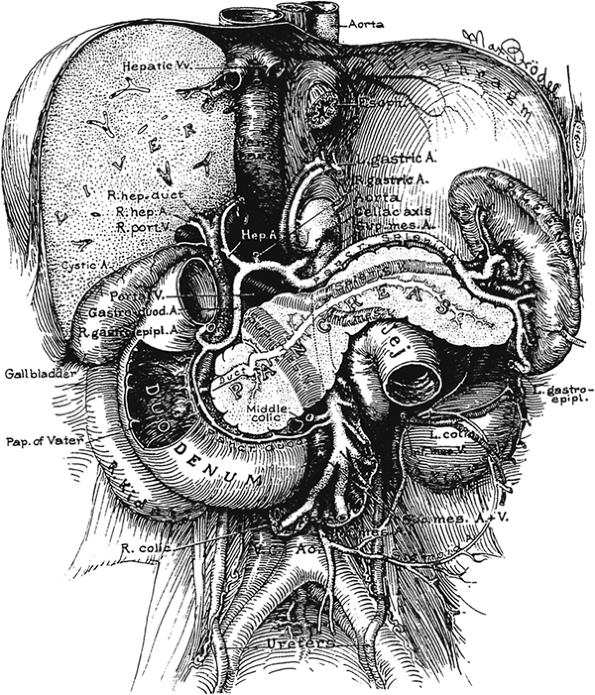 |
Figure 30.1 Anatomic relationships of the pancreas. The anterior aspect of the upper abdominal viscera is shown after removal of the stomach and omentum. Note the close relationship of the pancreas to the duodenum, jejunum, spleen, and major vessels. Drawing by M. Br del. Reprinted with permission from: Fawcett DW. Bloom and Fawcett: A Textbook of Histology. 12th ed. New York: Chapman & Hall; 1994. |
Because of the proximity of the pancreas to several organs and other anatomic structures, tumors of these sites may be difficult to distinguish radiographically. Pancreatic masses may be confused with neoplasms of the duodenum, the ampulla of Vater, the distal bile duct, the left adrenal gland, the superior poles of either kidney, the spleen, the left lobe of the liver, the greater curve of the stomach, the root of the mesentery, and the superior retroperitoneum.
A number of major blood vessels are closely related to the pancreas (5,6). The body rests on the aorta. The celiac trunk arises from the aorta superior to the neck of the pancreas and gives off the hepatic artery as well as the tortuous splenic artery, which runs superior to the pancreatic tail. The superior mesenteric artery arises posterior to the junction of the neck and body, and the adjacent superior mesenteric vein passes through a groove between the head and the neck, with a portion of the head (the uncinate process) extending around the superior mesenteric vessels to lie anterior to the aorta. The head of the gland also rests on the inferior vena cava, the right renal vessels, and the left renal vein. These major vessels all lie posterior to the pancreas, allowing for safe surgical access to the gland from the anterior aspect (7). The splenic vein accompanies the splenic artery along the superior aspect of the tail, joining the superior mesenteric vein to form the portal vein near the posterosuperior border of the head.
The arteries supplying the pancreas are primarily branches of the celiac trunk and the superior mesenteric artery (2,4). The arterial supply has many anastomoses between the different vessels, and numerous anatomic variations exist. The pancreatic head is supplied by the anterior and posterior pancreatoduodenal arteries, which form arcades in the pancreatoduodenal sulcus. The anterior or prepancreatic arcade is formed from the anterior superior pancreatoduodenal artery (a branch of the gastroduodenal artery) and the anterior inferior pancreatoduodenal artery (a branch of the superior mesenteric artery). The posterior arcade is formed from the posterior superior pancreatoduodenal artery (from the gastroduodenal artery) and the posterior inferior pancreatoduodenal artery (from the superior mesenteric artery). Venous drainage is by the pancreaticoduodenal veins, tributaries of the splenic and superior mesenteric vein (7).
The body and tail of the gland are supplied by the dorsal, inferior, and caudal pancreatic arteries and are drained by the inferior and left pancreatic veins. The dorsal pancreatic artery, also know as the superior pancreatic artery, has various origins, including the first 2 cm of the splenic artery, the hepatic artery, the celiac trunk, or the superior mesenteric artery. The right branch of the dorsal pancreatic artery extends across the pancreatic head and supplies the neck of the pancreas, joining the anterior pancreatic arcade. The left branch, known as the inferior pancreatic artery, runs along the inferior body of the pancreas.
Within the pancreas, a large branch of the splenic artery known as the great pancreatic artery, or pancreatica magna, provides left and right branches that course parallel to the main pancreatic duct. The right branch joins the inferior or dorsal pancreatic arteries, and the left branch joins the caudal pancreatic artery. Branches of these pancreatic arteries supply interlobular arteries, and one intralobular artery supplies each lobule.
Major lymphatic vessels follow the course of the blood vessels. Approximately 55% of interlobular lymphatics are closely related to the accompanying artery and vein, 25% are separated from other structures by connective tissue, and 20% are closely related to acinar cells. Only 2% border the ductal system (8). The interlobular lymphatics drain toward the surface of the pancreas and enter a surface network, sometimes referred to as collecting vessels, and converge toward the lymph nodes.
There are two major systems of lymph nodes draining the pancreas: one rings the pancreas and the other surrounds the aorta from the level of the celiac trunk to the origin of the superior mesenteric artery. Lymph nodes may be closely apposed to the periphery of the gland or even embedded within its substance, especially along the inferior and superior borders and in the anterior and posterior pancreatoduodenal
P.725
regions. Many lymph nodes are also found around the celiac axis, adjacent to the common bile duct, and at the splenic hilus (9). Several classification systems exist for these lymph nodes (9,10,11,12), although from the standpoint of involvement by carcinoma, the lymph node classifications appear not to have clinical significance.
Innervation of the pancreas is from the vagus nerve (parasympathetic) and the splanchnic nerves (sympathetic) via the celiac and superior mesenteric plexi (2,5). The course of the nerves accompanies the vasculature (4).
Gross Anatomy
In adults, the pancreas usually measures 15 to 20 cm in length and weighs 85 to 120 g. It is slightly larger in men than in women (6,13). The pancreas weighs 2 to 3 g in the newborn and reaches 7 g at 1 year of age (14). The weight of the gland gradually decreases after 40 years of age to a mean of 70 g in the ninth decade of life (13).
The pancreas is composed of four rather indistinct anatomic regions: the head, neck, body, and tail (Figure 30.2). The bulk of the organ is composed of the head, including the uncinate process, which develops separately and may be anatomically separate in some individuals (see below). The uncinate process (from the Latin uncus or hook ) extends inferiorly and posteriorly from the head of the gland and lies behind the pancreatic neck and the superior mesenteric vessels. These vessels frequently indent the uncinate process, producing the hook shape. This vascular sulcus is helpful for orienting the pancreas in pancreatoduodenectomy specimens. The neck of the pancreas is the short constricted area of the pancreas that rests anterior to the mesenteric vessels. The neck and body are somewhat triangular in cross section, whereas the distal-most tail is flat (2).
The normal pancreas is pink-tan to yellow and uniformly lobulated. The anterior surface is smooth and covered by a layer of peritoneum; the remaining surfaces are invested by a thin layer of loose fibroconnective tissue. No discrete capsule is present; and, depending on the amount of parenchymal fat and the extent of any fibrosis, the interface with the surrounding retroperitoneal adipose tissue may be indistinct.
Cut sections of the pancreas reveal arborizing thin-walled white ducts extending into the well-demarcated lobules. The main pancreatic duct of Wirsung averages 3.0 mm (ranging from 1.8 to 9.0 mm) in diameter (15), gradually enlarging to 4.5 mm near the ampulla of Vater, through which it drains into the duodenum. Main ducts greater than 10 mm in diameter are considered pathologically dilated. Up to 50 secondary or branch ducts drain into the main duct (16,17), entering alternately from either side in a herringbone pattern (Figure 30.3) (6). The course of the major ducts varies depending on the pattern of fusion and atrophy of ducts that occurs during development. In general, the main pancreatic duct of Wirsung begins in the tail, collecting tributaries as it passes through the body and neck toward the head. The duct makes an acute turn inferiorly in the head of the gland, where it is joined by the accessory duct of Santorini from the superior head as well as the major duct from the uncinate process, ultimately exiting through the ampulla at the major papilla. The accessory duct generally does not communicate separately with the duodenum, although retention of embryonic patency through the minor duodenal papilla is not uncommon.
 |
Figure 30.2 Gross appearance of the normal pancreas. The bulbous head (left) is connected to the neck, body, and tail, which merge imperceptibly. The parenchyma consists of distinctly lobulated pink-tan fleshy tissue. The pancreatic duct (opened longitudinally) is thin and smooth throughout its course. |
 |
Figure 30.3 Schematic diagram of the pancreas showing the pattern of the major ducts and their tributaries. In this example the accessory duct is patent at the duodenum through the minor papilla. Reprinted with permission from: Cubilla AL, Fitzgerald PJ. Tumors of the exocrine pancreas. In: Hartmann WH, Sobin LH, eds. Atlas of Tumor Pathology. 2nd series, fascicle 19. Washington, DC: Armed Forces Institute of Pathology; 1984. |
The relationship of the main duct to the distal common bile duct is also highly variable. The prototypical ampulla is a flask-shaped common channel within the wall of the duodenum formed by the fusion of the two ducts. A significant common channel is uncommon, however. In many cases, length of the common channel is less than 3 mm. In others, the two ducts remain separate throughout their course, entering side by side at the major papilla or completely separately (Figure 30.4) (4,13,18). In these individuals, a common channel does not exist or is extremely short. In one study, only 43% of individuals had a common channel greater than 3 mm in length (19). Villiform mucosal projections are present within the distal ducts; these valves of Santorini may prevent the reflux of duodenal secretions (20,21). The intraduodenal portions of the pancreatic and bile ducts are surrounded by thin fascicles of smooth muscle (the sphincter of Oddi), which are continuous with both the muscularis mucosae and the muscularis propria of the surrounding duodenum.
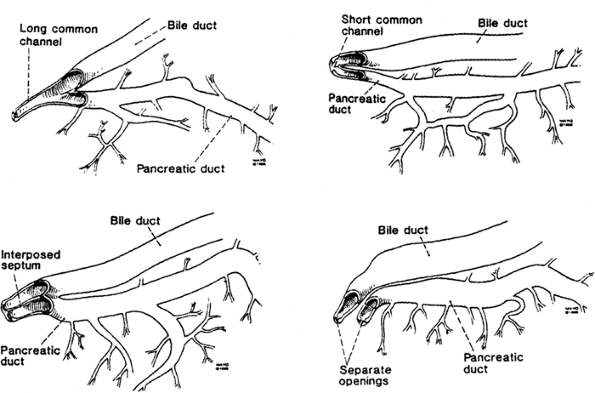 |
Figure 30.4 Anatomic variations in the paths of the pancreatic and bile ducts at the ampulla. A long common channel (the prototypical ampulla) is only present in some individuals. In others, the ducts fuse within only a few millimeters of the duodenum, resulting in a short common channel, or the two ducts enter separately. Reprinted with permission from: DiMagno EP, Shorter RG, Taylor WF, Go VL. Relationships between pancreaticobiliary ductal anatomy and pancreatic ductal and parenchymal histology. Cancer 1982;49:361 368. |
P.726
Development
Organogenesis
During the fourth to fifth weeks of gestation, the pancreas forms from the endoderm of the distal embryonic foregut as dorsal and ventral buds (22,23). The dorsal bud forms opposite the hepatic diverticulum, whereas the ventral bud, which may be bilobed, forms adjacent to the hepatic diverticulum (17). Thus, the duct from the ventral pancreas is closely apposed to the common bile duct. With the rotation of the duodenum during the sixth week, the ventral pancreas with the common bile duct migrates circumferentially to the right around the posterior aspect of the duodenum to lie posterior and inferior to the dorsal pancreas (Figure 30.5). The two portions generally fuse during the seventh week. The dorsal portion makes up the superior head as well as the entire neck, body, and tail of the adult gland, and the ventral portion becomes the remainder of the head, including the uncinate process (23). The ductal systems of the two lobes also normally fuse, with connection of the dorsal duct to the duodenum at the minor papilla being lost and the ventral duct providing the drainage for the exocrine secretions. Thus, the distal two-thirds of the main pancreatic duct (of Wirsung) develop from the embryonic dorsal duct, whereas the proximal one-third forms from the ventral duct. The complicated union of these different ducts accounts for the tortuous nature of the main pancreatic duct in adults. The remaining proximal portion of the dorsal embryonic duct becomes the accessory duct of Santorini. The ampulla of Vater develops during the eighth week.
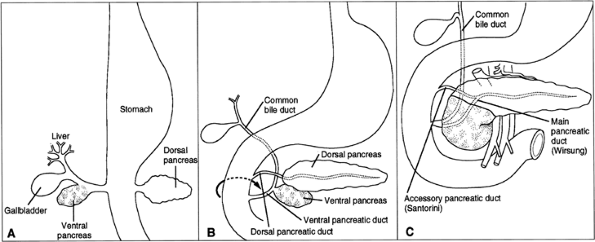 |
Figure 30.5 Development of the pancreas. The dorsal and ventral buds form on opposite sides of the duodenum (A). During the sixth week, the ventral pancreas migrates posteriorly around the duodenum (B) to lie inferior to the dorsal pancreas, where it comprises much of the head of the gland (C). Reprinted with permission from: Skandalakis LJ, Rowe JS Jr, Gray SW, Skandalakis JE. Surgical embryology and anatomy of the pancreas. Surg Clin North Am 1993;73:661 697. |
P.727
Cytogenesis
The complex events required for normal cellular development of the pancreas have three components (24). First, as described above, the foregut endoderm becomes patterned to form the dorsal and ventral pancreatic buds. Second, the cells undergo lineage commitment to either endocrine or exocrine cell fates. Third, pancreatic morphogenesis occurs by way of extensive growth and branching. Recent studies suggest that distinct signaling pathways control these events, but it is important to note that tissue specification, lineage commitment, and growth are highly interdependent and have considerable spatial and temporal overlap.
Several transcription factors are required for pancreas specification. Prior to and during budding, the pancreatic primordium expresses the homeodomain protein Pdx1 (also known as IPF1) (24), and Pdx1-positive progenitors give rise to all three epithelial cell lines (25). The developing ductal epithelium retains uniform Pdx1 expression, but later Pdx1 expression is lost in the ductal cells, being primarily restricted to the islet cells, with low levels detectable in some acinar cells. Under certain conditions, Pdx1 expression again becomes detectable in individual pancreatic ductal epithelial cells, raising the possibility of multipotential stem cells within the mature ductal epithelium (26).
Among others, additional transcriptional factors involved in pancreatic morphogenesis include Sox17, HLXB9, and PTF1; and many endocrine lineage-specific transcription factors are known, such as Ngn3, NeuroD/Beta2, Nkx2.2, and Nkx6.1 (27,28,29,30). However, little information exists regarding similar factors required for exocrine differentiation. The p48 component of the heterotrimeric PTF1 transcription factor complex is required for normal exocrine differentiation (31).
Pancreatic development is also regulated by cell fate determining signals from developmental patterning pathways, such as the Notch and Hedgehog (Hh) signaling pathways. Notch signals are required for epithelial branching and normal exocrine lineage commitment (32). Of the three hedgehog genes essential for mammalian embryogenesis (sonic hedgehog [Shh], Indian hedgehog [Ihh], and desert hedgehog [Dhh]), Shh expression in midgestational embryos is critical for proper foregut and gastrointestinal development. In contrast, Shh is excluded from the developing pancreas, and repression of Shh permits appropriate transcriptional activation of pancreatic genes (33).
The developing ducts form solid cellular cords that proliferate into the surrounding mesenchyme. As the ducts branch progressively, luminal spaces are formed. Both acinar and endocrine cells develop from these primitive ducts (34). The cells at the termini of the branches differentiate into acinar cells during the third month of gestation (34). The pancreatic lobules are formed by the accumulation of acinar units around ductular branches that are separated by layers of mesenchyme. By the fourth month the acinar cells contain zymogen granules (14). The earliest granules identified in acinar cells are elongated and angular, with a fibrillary internal matrix. These granules, along with small spherical granules, may be detected at 15 to 20 weeks gestation (23,35,36). By 20 weeks, the granules resemble the zymogen granules of the adult pancreas, and the elongate granules disappear. The nature of the elongate granules remains unclear, and enzymes have yet to be detected in them. However, it is interesting that similar irregular fibrillary granules have been repeatedly detected in pancreatic neoplasms with acinar differentiation (36,37,38,39,40,41).
Islet cells also develop from the ducts at 8 to 10 weeks gestation. Most of the islet cells appear to originate from the intralobular and interlobular ducts (16). In the third month, developing endocrine cell clusters bud off from the ducts and surround capillaries to form discrete islets (42,43). In even the earliest developing islets, differentiated and cells can be recognized (43,44,45). At 16 weeks the and cells segregate to opposite ends of the islets; these bipolar islets are gradually replaced between 18 and 20 weeks by mantle islets having a central core of cells surrounded by a rim of cells (34,43,45). Although the microscopic architecture of the mature adult islets is more complex, the peripheral location of the cells found in the mantle islets is roughly maintained.
During the third to fourth months, the pancreatic tissue becomes increasingly organized around the branching ductal structures to form lobules (Figure 30.6A B). The characteristics of the ductal lining cells specific to their level within the ductal system become established during this period. The mesenchymal elements of the early pancreas are prominent. The early periductal stroma is highly cellular (Figure 30.6C), resembling the ovarian-like stroma that characterizes mucinous cystic neoplasms (46,47). As the pancreas develops, the mesenchyme becomes increasingly less abundant and less cellular, ultimately constituting a relatively minimal component of the adult gland.
Developmental Anomalies and Heterotopia
Complete or partial pancreatic agenesis is rare. Complete agenesis is associated with gallbladder agenesis, diaphragmatic hernia, and growth retardation. A homozygous deletion in the Pdx1 gene was recently identified in a girl born with complete pancreatic agenesis (48), interesting because of the role Pdx1 plays in pancreatic development. Most patients with partial pancreatic agenesis survive; but, depending upon the amount of pancreatic tissue that develops, they may have diabetes mellitus. More common than pancreatic agenesis is pancreatic hypoplasia, also referred to as congenital short pancreas. This condition may be part of a congenital syndrome or present as an isolated anomaly. The pancreas appears short and stubby but otherwise retains the
P.728
normal appearing lobular architecture. Pancreatic hypoplasia typically is not associated with hypofunction.
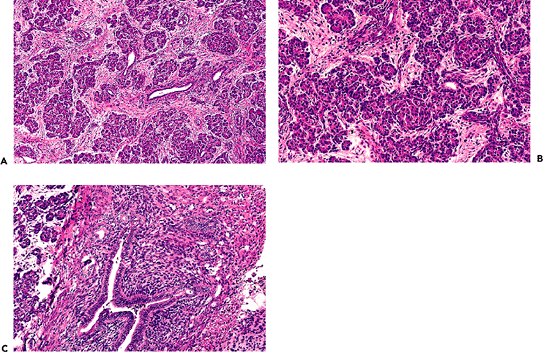 |
Figure 30.6 A. The fetal pancreas at 18 to 20 weeks of gestation exhibits a well-developed lobular architecture. The loose connective tissue between the lobules is relatively abundant. B. Both acinar and endocrine elements are well developed and are functioning at this stage. C. The mesenchyme surrounding the ducts is highly cellular, resembling the so-called ovarian-like stroma of mucinous cystic neoplasms. |
Annular or ring pancreas is an extremely rare developmental anomaly in which there is partial or complete encircling of the second part of the duodenum by pancreatic tissue (Figure 30.7) (4,49,50,51). Pancreas divisum usually accompanies annular pancreas (52), and the condition affects only 0.015% of the population (53). Possibly it is the failure of one of the lobes of the ventral embryonic bud to regress, causing it to encircle the duodenum during the normal rotation of the duodenum. Annular pancreas commonly causes duodenal obstruction, which varies in severity and age of onset, depending on the extent of luminal constriction. Some cases are also associated with duodenal atresia (51). The band of pancreatic tissue partially or completely encircling the duodenum is flattened and may be embedded within the muscularis propria. Histologically it contains all of the normal parenchymal elements. Because the portion of pancreas encircling the duodenum is derived from the ventral pancreas, it is rich in pancreatic polypeptide-containing islets (54).
There are many variations in the paths of the pancreatic ducts and their relationship to the common bile duct (17,51). The communication between the dorsal pancreatic duct and the duodenum fails to obliterate in up to 40% of adults (17,55), resulting in a patent accessory duct (of Santorini) at the minor papilla, proximal to the opening of the main duct and bile duct at the major papilla. In such instances, the dorsal duct may provide the main route of drainage for the gland and may be much larger in circumference than the ventral duct. This condition appears to be more prevalent in children, suggesting that obliteration of
P.729
the accessory duct opening may continue to occur in adulthood (56). Also, the two ducts may fail to fuse entirely, resulting in two separate ductal systems, a condition known as pancreas divisum. This anomaly occurs in 5 to 10% of individuals (17,57). The pancreatic parenchyma of the two lobes is usually fused (23), and the abnormality may not be detected unless a careful study of the ductal system is performed. There are three types of pancreas divisum: type 1, or classical pancreas divisum, involves total failure of duct fusion, causing most of the pancreatic secretions to drain through the duct of Santorini at the diminutive minor papilla, with the duct of Wirsung draining the small ventral pancreas through the major papilla; type 2 involves dominant dorsal drainage in which the ventral duct regresses completely, leaving the single dorsal duct and minor papilla as the only means of egress for exocrine secretions; and type 3 involves incomplete pancreas divisum, where a small communicating branch of the ventral duct remains (58). Patients with pancreas divisum seem to have a higher incidence of pancreatitis, especially when the opening of the dorsal duct at the minor papilla is small (51,57,59).
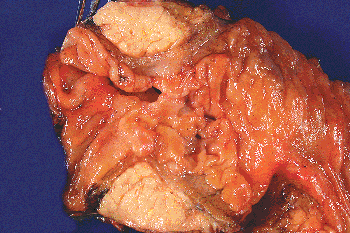 |
Figure 30.7 Annular pancreas. The pancreatic tissue completely encircles the duodenum, which is opened longitudinally. Reprinted with permission from: Hruban RH, Pitman MB, Klimstra DS. Tumors of the pancreas. In: Silverberg SG, Sobin LH, eds. Atlas of Tumor Pathology. 4th series. Washington, DC: Armed Forces Institute of Pathology; 2006. |
Anomalous junction of the main pancreatic duct with the distal common bile duct may occur within the head of the pancreas more than 2 cm proximal to the duodenum (17,51). This abnormality may be associated with choledochal cysts and carcinomas of the extrahepatic bile ducts or gallbladder (17,60,61). In a rare abnormality of the pancreatic duct, bifid pancreas, the main pancreatic duct bifurcates within the body of the pancreas (62).
Pancreatic heterotopia is defined as pancreatic tissue located outside of the normal anatomic position of the gland (51). Heterotopic pancreatic tissue is found in portions of the upper gastrointestinal tract and its appendages in up to 15% of individuals at autopsy (63). The surgical incidence, however, is only 0.2% (64). Of the cases detected during life, 25 to 50% are symptomatic (63,65). Although it is presumed to be congenital in origin, most symptomatic cases are detected in adulthood (65). The duodenum and stomach are the most common locations of pancreatic heterotopia (4,66), with most duodenal cases occurring in the second portion several centimeters proximal to the ampulla of Vater. Often the tissue is found in the submucosa beneath the minor duodenal papilla and represents remnants of the embryonic dorsal ductal system. Pancreatic heterotopia also may occur elsewhere in the duodenum and may involve the ampulla of Vater (67,68). Other sites of pancreatic heterotopia include the jejunum, Meckel's diverticulum, the large bowel, and the liver, where it is generally located around the bile ducts (69). In the tubular gastrointestinal tract, heterotopic pancreas appears as lobulated submucosal nodules of yellow to white firm tissue ranging from several millimeters to several centimeters in size. The overlying mucosa may be umbilicated in larger examples (Figure 30.8A). Rarely heterotopic pancreatic tissue is present on the serosal surface. Microscopically, the type and amount of the different pancreatic cell types varies. Most cases have ducts, and they may be the only epithelial component. Such cases have submucosal aggregates of small ducts and lobules of ductules, typically surrounded by interlacing smooth muscle fascicles, resulting in the appearance of so-called adenomyoma. Many cases do show some acinar and endocrine elements, and some resemble normal pancreatic parenchyma (Figure 30.8B). Some duodenal foci of heterotopic pancreas exhibit acini with the features of Brunner's glands, emphasizing the embryologic relationship these glands have with the pancreas (16). One of the important reasons to recognize heterotopic pancreas is to avoid misinterpretation of these ductules as carcinoma; however, cases of adenocarcinoma arising in heterotopic pancreas have been described (70,71,72), as have pancreatic pseudocysts.
 |
Figure 30.8 Heterotopic pancreatic tissue in the stomach. A. At low power, a submucosal nodule of pancreatic tissue results in an umbilicated appearance. B. In this example, lobules of normal-appearing acinar and ductular structures are separated by bands of fibromuscular tissue. Acini, ducts, and islets are arranged in a disorganized pattern, with interspersed bundles of smooth muscle. |
P.730
Heterotopic tissues also may be found within the pancreas. Accessory splenic tissue may be found in the tail of the pancreas or, more rarely, in the head (73). In most cases, the splenic tissue is small (less than 2 cm), dark red, and spherical. Intrapancreatic adrenal cortical tissue has also been described (74).
Microscopic Features
Microscopically, the pancreas is arranged in 1- to 10-mm lobules (Figure 30.9). The parenchyma within the lobules consists almost entirely of the epithelial elements of the pancreas, including the acini, the ducts, and the islets of Langerhans. There is minimal intralobular connective tissue, but fibroconnective tissue containing vessels and nerves separates the lobules.
Acini
Acinar cells make up approximately 85% of the mass of the pancreas and constitute the main exocrine secretory component of the gland. The prototypical architecture of the acinus in routine histologic sections appears to be a single layer of polygonal cells surrounding a minute central lumen, suggesting a spherical configuration (Figure 30.10); however, the three-dimensional architecture of the pancreatic acini is much more complex (75). In fact, tubular acini are commonly detected in histologic sections (Figure 30.11). Also, not all acini are located at the terminal end of ductules. Some acini bud from the sides of the ductules or are situated between two ductules. Anastomosing loops of acini also may be found (75). Thus, the secretions of a given acinus may pass through a number of different pathways to reach the ductal system.
Individual acinar cells are polarized, with basally situated round nuclei and apical granular eosinophilic cytoplasm. The eosinophilia of the apical cytoplasm reflects the accumulation of numerous zymogen granules (Figure 30.10), which contrast with the basophilic zymogen granules of salivary serous acini. The zymogen granule content is highly dynamic, depending on the secretory state of the pancreas, which is largely regulated by digestive hormones (1). The basal cytoplasm of the acinar cells is basophilic due to the high concentration of ribonucleoproteins in the abundant rough endoplasmic reticulum (RER). There may be a clear cytoplasmic zone on the luminal side of the nucleus that contains the Golgi apparatus. The nuclei are uniform and frequently contain distinct central nucleoli; clumps of chromatin are generally present beneath the nuclear membrane. The acinar cells sit directly upon the basement membrane; in contrast to salivary acini, there are no myoepithelial cells surrounding the pancreatic acini.
 |
Figure 30.9 At low power, the normal pancreas has a well-developed lobular arrangement of highly cellular glandular tissue. |
 |
Figure 30.10 Acinar cells contain abundant granular eosinophilic cytoplasm in the apical aspect, with basophilic basal cytoplasm. The nuclei are also basally located. Most acini consist of spherically arranged individual acinar cells. |
Although the acinar cells from different regions of the pancreas are all morphologically and functionally similar, there are subtle differences in the size and zymogen granule
P.731
content in the acinar cells immediately adjacent to islets compared with those distant from islets, perhaps as a reflection of regional variations in islet hormone levels (76,77).
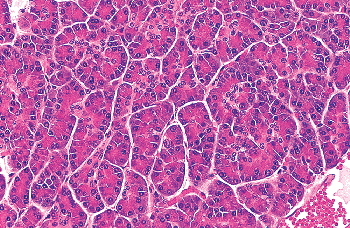 |
Figure 30.11 Other acini have tubular configurations and exhibit interanastomosing loops when studied by serial sectioning. |
 |
Figure 30.12 Zymogen granules are positive with periodic acid-Schiff's stain with diastase pretreatment. Islet cells (lower right) are negative. |
Zymogen granules stain positively with periodic acid-Schiff (PAS) stain and are resistant to diastase digestion (Figure 30.12). Acinar cells also can be demonstrated using stains for butyrate esterase, which is positive in the presence of enzymatically active lipase (38). Immunohistochemical labeling for pancreatic enzymes such as trypsin, chymotrypsin, lipase, amylase, and elastase is positive in acinar cells (Figure 30.13) and, with the exception of amylase, these are also sensitive markers for acinar differentiation in pancreatic neoplasms (38,39,40,78). Each individual zymogen granule contains all of the various digestive enzymes, usually in a proenzyme form (79,80). Keratins detected by the CAM 5.2 antibody (cytokeratins 8 and 18) are present in acinar cells; however, there is no labeling with the AE1 antibody nor is there with antibodies against cytokeratins 7, 19, and 20 (Figure 30.14). Mucins are not produced, and immunohistochemical labeling for glycoproteins such as DUPAN-2, CEA, and CA19.9 is negative. Finally, endocrine specific antibodies such as chromogranin and synaptophysin are negative as well.
 |
Figure 30.13 Immunohistochemical staining for trypsin results in intense labeling of acinar cells but not ductal and islet cells. Faint luminal labeling of ductal cells may be seen due to deposition of luminal enzymatic secretions on the apical cell surfaces (upper right). |
Ultrastructural examination shows features characteristic of active exocrine secretion. The RER is arranged in parallel stacks and fills the basal cytoplasm (Figure 30.15). Scattered mitochondria and free polyribosomes are present between RER cisternae (81). The Golgi apparatus is situated in the
P.732
central region of the cytoplasm near the nucleus. Immature electron-dense zymogen granules emanate from the trans side of the Golgi apparatus. Larger round, homogeneous mature zymogen granules are present within the apical cytoplasm. They measure 250 to 1000 nm and have limiting membranes closely apposed to the dense secretory content. Upon stimulation, the membranes of the secretory granules fuse with the apical plasma membrane, expelling the contents into the lumen; the excess cell membranes are then recycled to the Golgi apparatus (82,83). Accumulated secretions are often present within the lumina, sometimes with crystal formation. The luminal membranes have sparse, short microvilli containing inner microfilaments that are continuous with the terminal web of filaments beneath the apical membrane (81). Adjacent acinar cells are joined by apical junctional complexes composed of zonula occludens- and zonula adherens-type junctions, whereas desmosomes (macula adherens junctions) join cells along the basal aspects of their lateral membranes (14,81). Each acinus is surrounded by a continuous basement membrane.
 |
Figure 30.14 Immunohistochemical labeling for keratins. A. The CAM 5.2 antibody shows diffuse labeling of acinar cells and ductal cells, the latter being more intensely positive. B. The AE1/AE3 antibodies label only ductal cells. Islet cells show only focal faint labeling with any of these antibodies. |
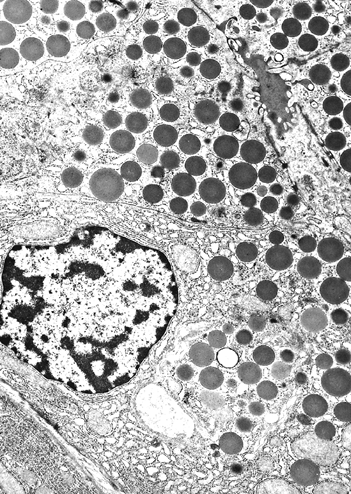 |
Figure 30.15 The ultrastructural appearance of acinar cells. These polarized cells have abundant parallel stacks of rough endoplasmic reticulum with interspersed mitochondria in the basal cytoplasm. Homogeneous electron-dense zymogen granules are concentrated in the apical cytoplasm underlying the lumina. The luminal spaces are lined by short microvilli. Adjacent acinar cells are joined to one another and to the centroacinar cells (*) by apical junctional complexes. The centroacinar cells have lucent cytoplasm devoid of secretory granules. |
Ducts
The ductal system of the pancreas serves to transport the acinar cell secretions to the duodenum. The ductal epithelial cells secrete water, chloride, and bicarbonate to buffer the acidity of the pancreatic juices and stabilize the proenzymes until activation within the duodenum. The ductal system is subdivided into five portions: centroacinar cells, intercalated ducts, intralobular ducts, interlobular ducts (large and small), and main ducts (84). The ductal system begins with the centroacinar cells, which are small, relatively inconspicuous, flat to cuboidal cells with pale or lightly eosinophilic cytoplasm and central oval nuclei (Figure 30.16). Centroacinar cells are located in the middle of the acini, where they partially border
P.733
the acinar lumina along with the acinar cells, to which they are joined by tight junctions. Ultrastructurally, the centroacinar cells have cytoplasm largely devoid of organelles, with only scattered mitochondria; no zymogen, neurosecretory, or mucigen granules are present. Relative to the acinar cells, the cytoplasm is less dense and rough endoplasmic reticulum is minimal. The cell surfaces contain scattered short microvilli similar to those on the adjacent acinar cells. Adjacent cells are joined by abundant junctional complexes, and there are often complex interdigitations between them. Some centroacinar cells have more abundant granular oncocytic cytoplasm (Figure 30.17) that reflects numerous mitochondria (84,85); the significance of this variation is unknown.
 |
Figure 30.16 A. Most centroacinar cells are inconspicuous small cells with minimal cytoplasm and oval nuclei situated in the center of the acini. B. In other regions the centroacinar cells may be more prominent, with more abundant lightly eosinophilic cytoplasm. Centroacinar cells constitute the beginning of the ductal system and convey the secretions of acinar cells to the intercalated ducts. |
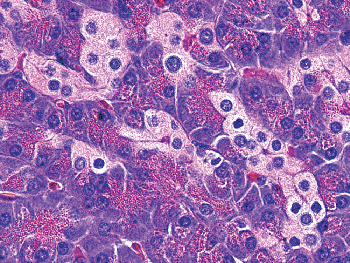 |
Figure 30.17 Some centroacinar cells are enlarged and have oncocytic cytoplasm, a variation of uncertain significance. |
The lumen surrounded by acinar and centroacinar cells drains into the intercalated ducts, which are the smallest ducts outside the acini (Figure 30.18). The cells lining the intercalated ducts resemble the centroacinar cells. They are cuboidal and have central oval nuclei with indistinct nucleoli. Mucins are not detected with Alcian blue or mucicarmine stains in centroacinar or intercalated duct cells. The intercalated ducts fuse to form the intralobular ducts, and the transition is imperceptible. The cells lining the intralobular ducts are essentially identical to those of the intercalated ducts, although the nuclei are round rather than oval (Figure 30.18). Neither intercalated nor intralobular ducts have a significant collagenous matrix surrounding them. The ductal cells rest directly on the basement membrane and lack both myoepithelial and basal cells; thus, in contrast to several other organs, the presence or absence of these cells cannot be used to help distinguish benign ducts from invasive pancreatic ductal adenocarcinoma.
Once the ducts leave the lobules, they become enveloped by a variably thick rim of collagen and are termed interlobular ducts (Figure 30.19). The interlobular ductal cells have slightly more cytoplasm than those of the intralobular ducts
P.734
and assume a low columnar shape in the larger ducts. As in the smaller ducts, cytoplasmic mucin is not detectable by routine histology in intralobular or interlobular ductal cells; mucinous cytoplasm visible by routine histology is considered a pathological change (see below). However, some cytoplasmic mucin may be found using special stains. As the interlobular ducts approach the main pancreatic ducts (of Wirsung or Santorini), they develop an increasingly thick collagenous wall within which lobular aggregates of small ductules may be seen, resembling the ductules of Beale that surround the major bile ducts (Figure 30.20).
 |
Figure 30.18 The ductal system within the lobules consists of innumerable intercalated ducts that fuse to form intralobular ducts. The cytologic appearance of the intercalated and intralobular ductal cells resembles that of the centroacinar cells, and the transition from one to the next is imperceptible. Only minimal collagenized stroma surrounds the intralobular ducts (lower right). |
 |
Figure 30.19 A. Intralobular ducts come together to form interlobular ducts. B. The interlobular ducts are surrounded by a variably thick rim of dense fibrous tissue and carry the pancreatic secretions to the major ducts, receiving tributaries of small interlobular ducts as they pass through the connective tissue septa of the gland. |
 |
Figure 30.20 A. The largest interlobular ducts are surrounded by a thick rim of collagen. B. Small lobular aggregates of ductules are present within the wall of the larger ducts. |
The main pancreatic ducts receive numerous tributaries of interlobular ducts (Figure 30.21). The lining epithelium remains flat, without papillary projections, except in the very distal duct within the ampulla, where simple papillae are found (Figure 30.22). The cells are low columnar with basal round nuclei. In these large ducts, there may be apical cytoplasmic clearing, reflecting mucin, but tall columnar cells with obvious abundant mucin are not normally found, and special stains or electron microscopy are often needed to identify the mucin (84). The mucins of the intralobular and smaller interlobular ductal cells are predominantly sulphomucins and stain positively with Alcian blue at pH 1.0 (Figure 30.23) (55,86). In the cells of the larger ducts, there are fewer sulfomucins and more neutral mucins and sialomucins (86). There is relatively frequent cell exfoliation in the main duct, perhaps reflecting a high turnover rate due to injury; degenerating cells may be observed within the epithelium by electron microscopy (81). The thick connective tissue wall contains numerous periductal ductules, as well as fascicles of smooth muscle (1).
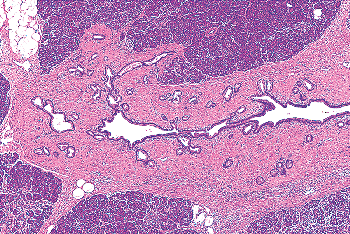 |
Figure 30.21 Numerous interlobular ducts join the main pancreatic duct along its course. |
Other than the appearance of increasing numbers of mucigen granules and increased exocrine secretory apparatus (RER, mitochondria, and Golgi) in the larger ducts, the ultrastructural appearance of the ductal cells resembles that of the centroacinar cells (Figures 30.24,30.25). In ductal cells from the level of the small interlobular ducts, single long kinocilia project from the cell surfaces (81,84); cross
P.735
sections of these cilia may be observed within the lumina of the ducts (Figure 30.24). The cilia are connected to basal bodies in the paranuclear cytoplasm and may function in mixing and propulsion of the pancreatic secretions (81).
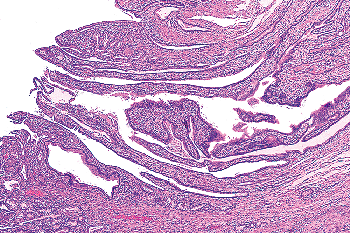 |
Figure 30.22 As the main pancreatic duct enters the ampulla of Vater, the ductal epithelium forms broad, simple papillae known as the valves of Santorini. |
 |
Figure 30.23 A. The cells of the intralobular and smaller interlobular ducts contain mucin in the apical cytoplasm that stains positively with Alcian blue/PAS. B. Staining with mucicarmine shows a similar distribution of mucin. |
Ductal cells contain cytokeratins 7, 8, 18, and 19; hence, they are immunohistochemically reactive with the AE1, AE3, and CAM 5.2 antibodies, in addition to antibodies against the specific individual cytokeratins (Figure 30.14). They do not express cytokeratin 20. Enzyme and endocrine markers are also negative. Carbonic anhydrase is detectable in ductal cells, reflecting their role in fluid and ion transport (87); most is detected in intercalated and intralobular ducts (88), although ducts of larger caliber may weakly express this enzyme (Figure 30.26).
P.736
Other markers of ductal cells include antibodies against CA19-9, DUPAN-2, cystic fibrosis transmembrane conductance regulator (CFTR), and N-terminal gastrin-releasing peptide (N-GRP) (89,90,91,92,93). Normal ducts do not label with antibodies to carcinoembryonic antigen when monoclonal antisera are used (94) and also fail to label for B72.3 and CA125. Members of the MUC family of glycoproteins are variably expressed; MUC1 is present in smaller intralobular and intercalated ducts, MUC6 is expressed in centroacinar cells and intercalated ducts; MUC2 and MUC5AC are not normally expressed (95,96).
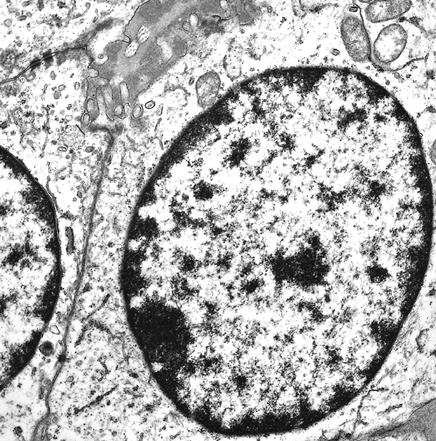 |
Figure 30.24 Ultrastructural appearance of intralobular ductal cells. The cytoplasm resembles that of centroacinar cells, with an electron-lucent appearance and scattered mitochondria and rough endoplasmic reticulum. In the smaller ducts, mucigen granules are largely absent. The luminal surface exhibits short microvilli. In addition, scattered cilia are present, the cross section of which may be seen within the lumen (top). |
 |
Figure 30.25 In the larger ducts, more abundant mucigen granules accumulate within the apical cytoplasm. These granules vary in size and have irregular contours and heterogeneous, variably electron-dense secretory contents. There are complex interdigitations of the lateral membranes between adjacent cells. |
Islets of Langerhans
The endocrine component of the pancreas constitutes only 1 to 2% of the volume of the gland in adults (1,77) but about 10% in the newborn (55,97). The vast majority of endocrine cells are found in the over one million islets of Langerhans, first described by Paul Langerhans in 1869. Although islets are distributed throughout the pancreas, they are somewhat more numerous in the tail (98). Apparently random variations in islet concentration may occur from one lobule to the next, resulting in the appearance of plentiful islets in one area and sparse islets in an adjacent region (Figure 30.27).
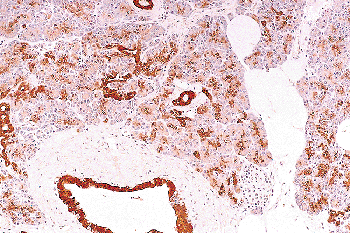 |
Figure 30.26 Immunohistochemical staining for carbonic anhydrase. In this preparation, there is staining of ductal cells of all sizes, including centroacinar, intercalated duct, and intralobular and interlobular ductal cells. |
The apparent volume of islets observed in histologic sections also varies with the age of the individual and the presence and extent of exocrine atrophy, as commonly occurs in chronic pancreatitis. In the fetus and neonate, the relative volume of endocrine cells far outmeasures that of the adult, especially in the portions derived from the dorsal lobe (Figure 30.28) (99).
Two types of islets are found. Most (90%) are the compact islets: sharply circumscribed nests usually measuring 75 to 225 m, although islets as small as 50 m or as large as 280 m also may be found (100). Compact islets are found predominantly in the body and tail of the gland, with fewer in the head. The second type of islet, the diffuse islet, is essentially restricted to the posteroinferior head of the gland derived from the embryonic ventral lobe (101,102). These islets are much less numerous than the compact islets and may measure up to 450 m.
Despite the circumscribed appearance of the compact islets, they are actually composed of interdigitating trabeculae that appear as small lobules in cross section (100). The cells of the compact islets have uniform round nuclei with coarsely clumped chromatin and inconspicuous nucleoli (Figure 30.29). The cytoplasm is pale and amphophilic. Occasional islet cells have nuclei two to four times the size of their neighbors, although no irregularities of shape or chromatin pattern are present. These nuclei have a 4n or 8n DNA content and have been shown to occur exclusively in cells (103); they do not have any pathologic significance. Mitotic figures are only rarely encountered in normal islets (104). The islets contain numerous small vessels, although these capillary-sized vessels are almost inapparent by light microscopy. Essentially all of the islet cells contact the vasculature. In
P.737
contrast to those supplying the acinar tissue, the capillaries of the islets have a fenestrated endothelium (1). A thin layer of connective tissue separates the compact islets from the surrounding acinar tissue, but they are not truly encapsulated.
 |
Figure 30.27 As highlighted by immunohistochemical labeling for chromogranin, the concentration of islets varies considerably from one lobule (A) to the next (B). |
Diffuse islets have a trabecular appearance, with winding cords of cells intermingled among acini (Figure 30.30A). Because they are less commonly encountered and have a pseudoinfiltrative appearance, they may be mistakenly regarded as neoplastic, an occurrence even more likely in the setting of chronic pancreatitis. In addition to the architectural differences already mentioned, the diffuse islets contain columnar cells within the trabecula. The cytoplasm is basophilic, the nuclei are somewhat hyperchromatic, and there may be more prominent nucleoli than in the compact islets (Figure 30.30B).
Each endocrine cell produces only one specific peptide hormone. The four major peptides produced by islet cells are insulin, glucagon, somatostatin, and pancreatic polypeptide (105). Although some pancreatic endocrine neoplasms produce ectopic peptides such as gastrin or vasoactive intestinal polypeptide, these are not found in normal islet cells. Classical histochemical staining was used to distinguish the different cell types. Aldehyde-fuchsin stains insulin-secreting cells, the Grimelius silver stain labels glucagon-secreting cells, and the Hellerstrom-Hellman silver stain identifies somatostatin-secreting cells. Immunohistochemical labeling with antibodies against insulin, glucagon, somatostatin, and pancreatic polypeptide provides a more specific method to distinguish the cell types. There is a fairly consistent distribution of the cell types within the compact islets. The cells are more centrally located, whereas the cells populate the periphery of the islets (Figures 30.31,30.32). Beta cells constitue 60 to 70% and cells make up 15 to 20% of the compact islets,
P.738
P.739
whereas the cells are much less numerous (100,106). Alpha cells are generally found in close contact with cells (42), and PP cells are rare in the compact islets, being concentrated in the diffuse islets where they constitute the majority (70%) of the cells (Figure 30.33) (107,108). The remaining cells of the diffuse islets are largely cells (20%), with minor amounts of and cells (5% of each). The difference in proportion of cell types between the compact and diffuse islets reflects their different embryologic origins (101,102). The relative proportion of the different peptide-producing cells also varies with age; for instance, the ratio of to cells in the compact islets is manyfold higher in adults than in infants, in whom cells constitute one-third of the islet cell population (97,109). All of the islet cells also express general endocrine markers such as neuron-specific enolase, CD56 (neural cell adhesion molecule), synaptophysin, and chromogranin (Figure 30.34). The last marker is expressed more intensely in cells than in cells, and the pattern of labeling also reflects the characteristic distribution of the cell types in the compact islets.
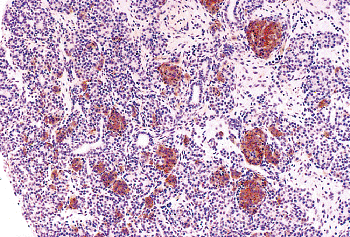 |
Figure 30.28 A fetal pancreas stained immunohistochemically for chromogranin. Note the abundance of endocrine cells relative to acinar cells at this stage of development. |
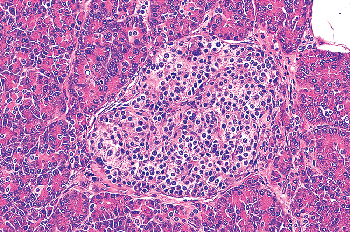 |
Figure 30.29 Compact islets consist of round to oval, generally circumscribed collections of endocrine cells. Small capillaries separate the islet into lobules. The nuclei have a stippled chromatin pattern, and there is moderate amphophilic cytoplasm. Some islet cells contain enlarged nuclei several times the size of those in the neighboring cells. |
 |
Figure 30.30 A. Diffuse islets are composed of trabeculae of endocrine cells interspersed between adjacent acini. B. The borders of the diffuse islets are ill defined. The cells have somewhat basophilic cytoplasm. |
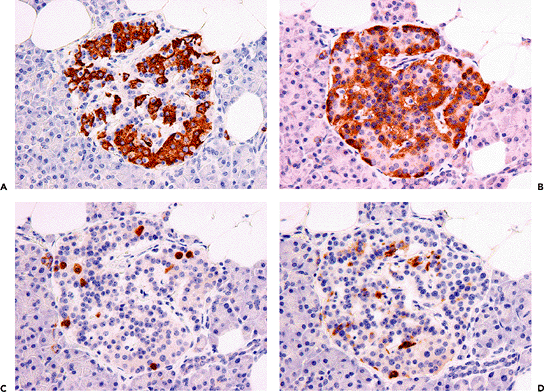 |
Figure 30.31 The distribution of the different peptide-producing cells within the islets of Langerhans. Beta cells (labeled for insulin) are the most numerous (A) and are situated in the central regions of the islet. Alpha cells (labeled for glucagon) are generally arranged around the periphery (B). Delta cells (labeled for somatostatin) (C) and PP cells (labeled for pancreatic polypeptide) (D) are much less numerous and do not display an obvious pattern of arrangement. |
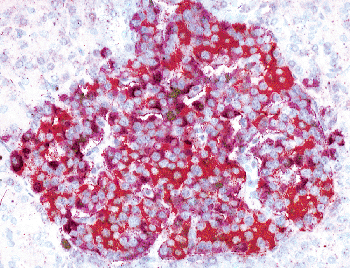 |
Figure 30.32 Triple immunohistochemical labeling of a compact islet for insulin (red-brown reaction product), glucagon (violet reaction product), and somatostatin (green reaction product) shows the characteristic distribution of the different cell types. |
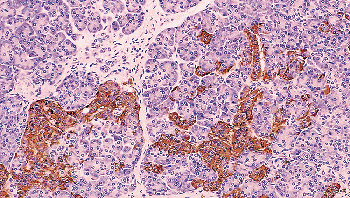 |
Figure 30.33 Immunohistochemistry for pancreatic polypeptide shows positive staining in most of the cells in the diffuse islets. |
Keratins generally are not detected in islet cells by immunohistochemistry, although there may be some faint labeling with CAM 5.2. Enzymes also are not detectable. Progesterone and CD99 receptors are expressed in normal islets as well as in some pancreatic endocrine neoplasms (110,111,112). The homeodomain protein Pdx1, a transcription factor important in pancreatic development, is also expressed in adult islet cells.
Ultrastructural examination of the islets shows polygonal cells joined by tight and gap junctions, suggesting that there may be electronic or metabolic coupling between adjacent cells (42,100). Scattered desmosomes are also present. The cytoplasm contains all of the organelles necessary for protein synthesis, including RER, mitochondria, and
P.740
Golgi apparatus; however, the abundant parallel arrays of RER characteristic of acinar cells are absent (Figure 30.35). The granules are also more randomly distributed within the cytoplasm, with some concentration in the basal cytoplasm adjacent to the capillaries into which they are secreted. The granule sizes and morphologies are relatively specific for each cell type (105,113). Alpha cell granules measure 200 to 300 nm and contain an eccentrically located, dense core within a less dense outer region that is separated from the limiting membrane by a thin halo (Figure 30.36A). Beta cells contain 225- to 375-nm granules with either a finely granular or a crystalline core surrounded by a wide halo underlying the limiting membrane (Figure 30.36B). Cytoplasmic lipid inclusions (or ceroid bodies) are often found in
P.741
cells (Figure 30.35) (42). Delta cell granules are slightly smaller (170 to 220 nm) than cell granules and have a uniformly dense core (Figure 30.36C). Delta cells have cytoplasmic processes extending toward the and cells, presumably allowing local paracrine release of somatostatin in addition to systemic release into the bloodstream (100). The PP cells of the ventrally derived portion of the pancreas have 180- to 220-nm granules of variable shape and density, whereas the PP cell granules of the remainder of the pancreas are smaller (120 to 150 nm) and more homogeneous (Figure 30.36D) (55). The cells are separated from the fenestrated endothelial cells of the capillaries only by the basement membranes of both cells and minimal interstitial material (42).
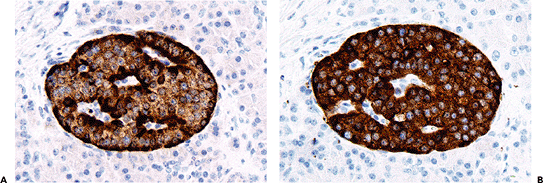 |
Figure 30.34 Alpha cells stain more intensely for chromogranin than do cells (A), whereas all of the islet cells stain uniformly for synaptophysin (B). |
 |
Figure 30.35 Ultrastructural appearance of islets of Langerhans. The islets are circumscribed and separated from the adjacent acinar cells (left). The peptide granules are randomly distributed within the cytoplasm. Lipid inclusions (ceroid bodies) are found within the cells. |
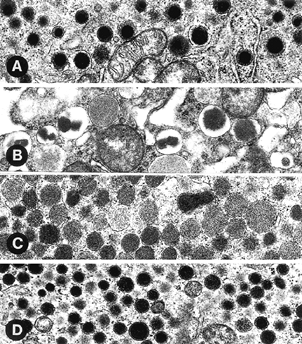 |
Figure 30.36 Ultrastructural appearance of islet cell granules. A. Alpha cell granules are round and contain an eccentric electron-dense core within a less dense peripheral region. There is a thin halo beneath the limiting membrane. B. Beta cell granules are polymorphous and contain crystalline cores with a wide halo beneath the limiting membrane. C. Delta cell granules are round with a moderately dense core surrounded by a very thin halo. D. The granules of PP cells are smaller and have homogenous hyperdense cores. Reprinted with permission from: Terada T, Ohta T, Sasaki M, Nakanuma Y, Kim YS. Expression of MUC apomucins in normal pancreas and pancreatic tumours. J Pathol 1996;180:160 165. |
Extrainsular Endocrine Cells
In addition to the endocrine cells of the islets of Langerhans, there are small numbers of individual endocrine cells within the ducts and scattered among the acini (Figure 30.37). These extrainsular endocrine cells are especially abundant during infancy, but they constitute less than 10% of the total pancreatic endocrine cell population in the adult (55). The ductal endocrine cells are most commonly detected in the main and larger interlobular ducts and are rare in the smaller ducts (84,114). Some of them border the lumina and are joined to neighboring ductal cells by tight junctions (115), whereas others are situated between the ductal cells and the basement membrane. They may secrete peptides directly into the pancreatic ducts, accounting for the detection of endocrine peptides in pancreatic juice (115). Specific peptides may be found, especially insulin, somatostatin, and pancreatic polypeptide (114,116). Some of the extrainsular endocrine cells in the larger ducts also produce serotonin (116); these cells may be the origin of the extremely rare true carcinoid tumors of the pancreas (117,118). The number of ductal endocrine cells appears to increase in the presence of proliferation of the ductal epithelium (Figure 30.38) (114).
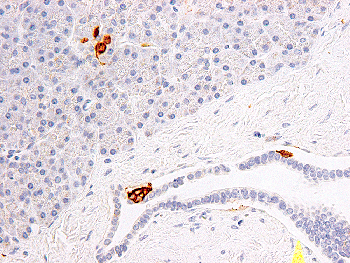 |
Figure 30.37 Extrainsular endocrine cells within the ducts and between the acini are only detectable with immunohistochemical labeling for chromogranin. |
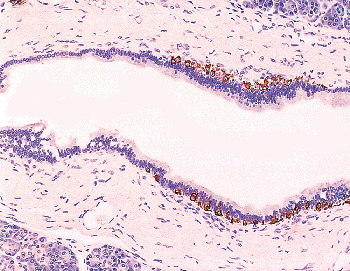 |
Figure 30.38 The number of ductal endocrine cells is increased in areas showing proliferation (the earliest stage of pancreatic intraepithelial neoplasia, PanIN-1) of the ductal epithelium (right). |
Connective Tissues
In the normal adult pancreas, there is little connective tissue between the lobules and almost none within them. In the neonatal pancreas, mesenchymal tissue comprises nearly 30% of the volume of the gland; it gradually decreases during infancy (97). The acini are surrounded by basement membranes, but very little other collagen is present (Figure 30.39).
Small portal vessels exist that deliver hormonal secretions from the islets directly to the exocrine elements of the gland (76,77,119,120). A complex capillary network surrounds the acini, and accompanying nerve fibers may be found. The acini and ducts are innervated by bundles of unmyelinated nerves that travel through the interlobular connective tissues. In most cases the nerve endings are separated from the acinar or ductal cells by the basement membrane, although in some cases direct contact with the basal cell membrane of acinar cells may be seen (84). Islets are innervated by both sympathetic and parasympathetic fibers; in addition, there are peptidergic fibers from the autonomic ganglia. Some of the periacinar nerves produce neuropeptide Y, whereas vasoactive intestinal polypeptide containing nerves are found within islets and adjacent to ducts (121). Other peptides found in pancreatic nerves include substance P, cholecystokinin, and calcitonin gene related peptide (121). Small autonomic
P.742
ganglia are located between clusters of acini (Figure 30.40). Paraganglia also may be found occasionally in the peripancreatic tissues. The muscular arteries run in the interlobular connective tissue, away from the centrally located pancreatic ducts. This separation of the ducts and muscular arteries is maintained in chronic pancreatitis, and presence of a gland close to a muscular artery suggests that the gland is malignant (122).
 |
Figure 30.39 Connective tissues are minimal within the pancreas. A. Collagen is largely restricted to the tissues surrounding the interlobular ducts, with only thin bands extending into the lobules (trichrome). B. Immunohistochemical staining for type IV collagen shows that an extensive network of basement membranes surrounds each acinus and duct and accompanies the capillaries within the islets (upper left). |
In almost every individual, there are some adipocytes within the pancreas. The proportion of the gland composed of fat varies from 3 to 20% (6). The amount of adipose tissue in the pancreas varies with the nutritional state and the age of the individual, older or overweight individuals having more intrapancreatic fat (123). The portions of the gland derived from the dorsal lobe may have more intraparenchymal fat than those from the ventral lobe (124,125).
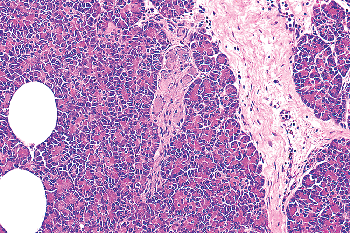 |
Figure 30.40 Small autonomic ganglia are located within lobules of acinar tissue. |
Recently a population of vitamin A storing fibroblast-like stromal cell has been described (126). These pancreatic stellate cells are biologically and morphologically similar to hepatic stellate (or Ito) cells, and activation of these cells appears to play a major role in the production of extracellular matrix proteins during the development of fibrosis in chronic pancreatitis (126). Another recently described stromal cell type is the interstitial cell of Cajal. Pancreatic interstitial cells of Cajal have the same morphological and immunophenotypic properties as do those in the tubular gastrointestinal tract, including immunohistochemical labeling for CD117 (127).
Cytological Features
Normal pancreatic epithelial cells are commonly encountered in cytological preparations such as fine needle aspiration specimens. In aspirates of normal pancreas, acinar cells predominate over other elements. However, most fine needle aspirations are performed to diagnose solid or cystic neoplasms, and any nonneoplastic epithelium in these specimens usually originates from areas of chronic pancreatitis within or adjacent to the neoplasm, where acinar elements are atrophic and ducts remain. Thus, nondiagnostic aspirates of pancreatic adenocarcinoma often contain relatively few acini and moderate amounts of ductal epithelium. Atypia in this ductal epithelium can present a diagnostic pitfall.
Cytologically, acinar cells appear predominantly as cohesive, small grape-like clusters with scattered single cells and occasional stripped nuclei (Figure 30.41) (128,129). The round, regular nuclei are usually central to eccentric and have uniform chromatin and variably prominent or even conspicuous nucleoli. The polygonal cells have abundant granular cytoplasm that stains blue-green with the standard
P.743
Papanicolaou stain and purple with the Romanowsky's stain. The individual granules may be visible depending on the specific stain. The Romanowsky's stain also reveals scattered small cytoplasmic vacuoles. The architectural arrangement of the cells is key to differentiating benign acinar cells from an acinar neoplasm, the latter generally forming large sheets and clusters as opposed to the small, uniform grapelike clusters of benign acini.
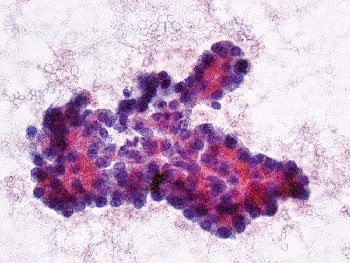 |
Figure 30.41 Cytology of normal acinar cells. There are grapelike clusters of cohesive cells with basal round nuclei having prominent nucleoli. The eosinophilic zymogen granules are apparent in the apical cytoplasm. |
Normal ductal epithelium appears cytologically as large, flat cohesive sheets of epithelium containing round, uniform, evenly spaced nuclei that impart a honeycombed appearance (Figure 30.42) (128,129). The cytoplasm of these cells can best be seen when the epithelium is present in strips, yielding a picket fence arrangement, or in sheets with a sharp luminal edge. Ductal cells have round to oval nuclei with even chromatin and generally small, inconspicuous nucleoli. The dense, nongranular and nonvacuolated cytoplasm stains aqua-blue with the Papanicolaou stain and more indigo-blue to purple with the Romanowsky's stain. Features consistent with a nonneoplastic process on cytology include cohesion and nuclei with uniform size, shape, spacing, and chromatin pattern. Abundant mucinous cytoplasm may be seen in ductal cells with low-grade pancreatic intraepithelial neoplasia (see below), but mucinous ductal epithelium also raises the possibility of a mucinous cystic neoplasm, an intraductal papillary mucinous neoplasm, or even an infiltrating adenocarcinoma.
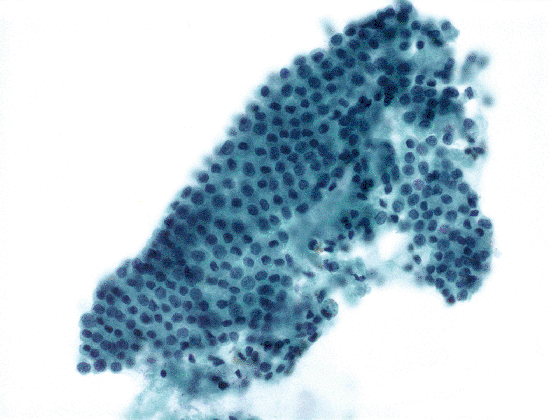 |
Figure 30.42 Cytology of normal ductal cells. There are sheets of evenly arranged cells with the characteristic honeycombed appearance. The nuclei are round and uniform. |
Islet cells are rarely appreciable in aspirate smears. Islet cells are uniform and polygonal with round nuclei, coarsely clumped chromatin, inconspicuous nucleoli, and pale amphophilic cytoplasm.
Minor Alterations
A number of minor alterations may affect various components of the pancreas due to physiologic changes, response to injury, or aging. Some of these changes are so subtle that they may be overlooked, but others may be confused for a neoplastic process. Recognition of these potential diagnostic pitfalls is essential for the accurate interpretation of biopsies and is complicated by the fact that many of these alterations may accompany pancreatic neoplasms.
Acinar Cells
Acinar cell nodules are common incidental findings that consist of circumscribed clusters of acini showing cytoplasmic or nuclear differences from the surrounding acini (130,131). Alternative terms include atypical acinar cell nodule, focal acinar transformation, eosinophilic degeneration, and focal acinar cell dysplasia (13,55,132,133). The last term suggests the lesion may be preneoplastic, but there is no proof of neoplastic alterations in acinar cell nodules in humans, where they are found in nearly half of nontumorous pancreata (134). The lesions are more prevalent in adults, suggesting that they are acquired (132). Although sometimes larger, acinar cell nodules are often similar in size to compact islets, with which they may be confused.
Two types of acinar cell nodules exist (131). The more common is the eosinophilic type, which appears as an abnormally pale, eosinophilic cluster of acini (Figure 30.43A). At high power, the cells are larger than the adjacent normal acinar cells, and the deep basophilia of the basal cytoplasm is lacking. The cytoplasm also may be vacuolated. The nuclei appear normal or hyperchromatic. This change is due to
P.744
dilatation of the RER (135) and may be a result of localized hypoxia or other degenerative phenomena. The other less common type of acinar cell nodule, the basophilic type, exhibits a loss of the eosinophilic zymogen granules from the apical cytoplasm, as well as an increased nucleus-to-cytoplasm ratio (Figure 30.43B). Nuclear enlargement, mild atypia, and prominent nucleoli also may be seen. The reason for such localized depletion of zymogen granules is unclear.
 |
Figure 30.43 Atypical acinar cell nodules. A. The eosinophilic type is more common and consists of a collection of acini showing loss of basophilia in the basal cytoplasm and hyperchromasia of the nuclei. The eosinophilic granules within the apical cytoplasm are maintained. An islet of Langerhans, with which these lesions may be confused, is present at lower right. B. The basophilic type of atypical acinar cell nodule exhibits an increased nucleus to cytoplasm ratio with loss of eosinophilic granularity of the apical cytoplasm. Some degree of nuclear atypia is also present. |
Acinar ectasia refers to the dilatation of acinar lumina that may occur during active secretion (1) or due to ductal obstruction (133). Acinar ectasia is also a relatively common finding at autopsy, where it is associated with premortem uremia, septicemia, and dehydration (13,136,137). Acinar ectasia often involves an entire lobular unit. The ectatic acini resemble small ductules, with flattened lining cells, but some of the cells are still recognizable as acinar cells that have lost most of their zymogen granules (Figure 30.44). Centroacinar cells also line the dilated lumina and may proliferate (137). The dilated lumina often contain retained eosinophilic secretions.
Metaplastic changes less commonly involve the acini than the ducts; they include replacement by mucinous cells or squamous cells (138). Proliferating centroacinar cells may appear to replace the acinar cells, especially in the presence of early atrophy (133). The possibility that acinar cells may transform into centroacinar or ductular cells ( acinar to ductal metaplasia ) has been suggested, especially in animal models of pancreatic neoplasia (139), but the occurrence of acinar to ductal metaplasia in humans is speculative (140).
Ductal Cells
Many metaplastic changes may affect the pancreatic ducts, including squamous, oncocytic, goblet cell (intestinal), and acinar metaplasia. However, the most common alteration in ductal cells, especially those of the medium-sized and large pancreatic ducts, is the replacement of the cuboidal, nonmucinous epithelium with tall columnar cells containing abundant luminal mucin that is easily appreciable on routinely stained slides (Figure 30.45A), resembling gastric foveolar or pyloric gland cells (141,142,143). For many years, this alteration was regarded as mucinous
P.745
metaplasia (or mucous cell hypertrophy, or pyloric gland metaplasia). The change is present in up to half of nontumorous pancreata (13,16,133,142,144,145) and is usually more prevalent in the head of the gland (144). The ductal epithelium may remain flat, or there may be formation of micropapillae or true papillae with fibrovascular cores (Figure 30.45B). The lesion may involve a single ductal profile or may extend into clusters of ductules adjacent to larger ducts. The latter circumstance results in the appearance of collections of small back-to-back tubules of mucinous cells and has been termed adenomatous hyperplasia (141); it is particularly associated with areas of chronic pancreatitis (Figure 30.46). With the increasing knowledge of the molecular genetic events that occur in pancreatic ductal adenocarcinomas, it has become increasingly apparent over the past decade that these mucinous changes in the ductal epithelium share some of the genetic abnormalities of invasive carcinomas (such as activating mutations in codon 12 of the KRAS oncogene and telomere shortening (146,147,148,149,150,151)) and that they form the beginning of a spectrum of preinvasive neoplasia that also includes ductal lesions with increased degrees of cytoarchitectural atypia (141,142,145,152,153,154).
P.746
Thus, the lesions previously designated as mucinous metaplasia are now regarded to be the earliest stage of pancreatic intraepithelial neoplasia (or PanIN) and are termed PanIN-1 (155,156). Since not all mucinous ductal lesions have detectable oncogene mutations, it is possible that a histologically indistinguishable subset is not truly neoplastic; thus, an alternative designation is PanIN/L-1, the L referring to lesion . The PanIN-1 lesions with flat epithelium are referred to as PanIN-1A; those with micropapillae or true papillae are referred to as PanIN-1B.
 |
Figure 30.44 In acinar ectasia, the acinar lumina are dilated and filled with eosinophilic secretions. The lining cells have a flattened appearance, often resembling small ductules cells more than acinar cells. |
 |
Figure 30.45 Pancreatic intraepithelial neoplasia (PanIN)-1. A. In PanIN-1A, the normal cuboidal to low columnar ductal epithelial cells are replaced by tall columnar cells containing abundant apical mucin. The nuclei remain basally located and show minimal pseudostratification. B. PanIN-1B has similar cytological features but demonstrates papilla formation. Note the transition to normal ductal epithelium (left). |
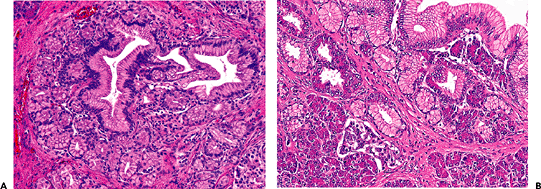 |
Figure 30.46 A. PanIN-1 may involve aggregates of small ductules around larger ducts, resulting in clusters of mucinous glands, a finding previously referred to as adenomatous hyperplasia ( Cubilla AL, Fitzgerald PJ. Morphological lesions associated with human primary invasive nonendocrine pancreas cancer. Cancer Res 1976;36 (pt 2):2690 2698. ). B. Because the smallest components of the ductal system are involved, cells with PanIN-1 may abut adjacent acinar cells. |
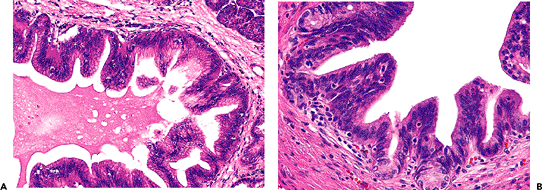 |
Figure 30.47 A. PanIN-2 is characterized by pseudostratified nuclei showing focal loss polarity. B. At higher power, the nuclei are enlarged, moderately atypical, and overlapping. |
Ductal proliferative lesions with greater degrees of cytoarchitectural atypia are considered higher grades of PanIN. Most PanIN-2 lesions (previously designated as atypical hyperplasia or moderate dysplasia) are micropapillary, but some may be flat; PanIN-2 shows nuclear abnormalities, including early loss of polarity with full-thickness pseudostratification as well as nuclear crowding, enlargement, and hyperchromasia (Figure 30.47). Mitoses are found rarely and, when present, are basal and morphologically normal. The PanIN-3 lesions (previously designated carcinoma in situ or severe dysplasia) demonstrate more significant architectural and cytological atypia (Figure 30.48). These lesions are usually papillary or micropapillary, although rarely they may be flat. Cribriforming, budding off of clusters of cells into the lumen, and luminal necrosis may occur. Also, the nuclei show complete loss of polarity and are enlarged, hyperchromatic, and irregular. The nucleus-to-cytoplasm ratio is increased. Nucleoli can be prominent, and mitoses are usually identifiable, including atypical forms (155,156). Higher grade PanINs contain more of the mutations of invasive carcinomas, including
P.747
inactivating mutations in p16/CDKN2A (present at the PanIN2 stage), SMAD4, TP53, and BRCA2 (all present in PanIN-3). Also, hypermethylation of the ppENK, TSLC1, and p16 genes has been demonstrated in PanINs, the prevelance increasing from PanIN-1 through PanIN-3 (146,147,148,149,150,151). The proliferation rate, as measured by immunohistochemical staining for Ki-67, increases with increasing grades of PanIN (157).
 |
Figure 30.48 A. In PanIN-3, there is complete loss of polarity, with budding of disorganized cellular clusters into the ductal lumen. The nuclei are markedly irregular and vary in morphology between adjacent cells. Increased mitoses are present. B. In another focus, architectural abnormalities include cribriforming, and there is extreme nuclear atypia. |
Multiple grades of PanIN tend to coexist within the same pancreas, with gradual transitions from one to the next. All grades of PanINs are associated with invasive ductal adenocarcinomas (92,141,142), and PanIN-3 is usually only found in pancreata also harboring an invasive ductal adenocarcinoma (141,142), although it can occur in a pancreas without invasive carcinoma. Along with the genetic data, these observations support the concept that PanINs progress to carcinoma, but the frequency and time course of progression is unknown. The cells in foci of PanIN produce largely neutral mucins and sialomucins; sulfomucins are less abundant than in normal ductal cells (55). The histochemical and immunohistochemical profile of the mucins in these cells resembles that of the superficial gastric mucosa in some cases or of the pyloric glands in others (93,143). Because there is little morphologic difference between these two mucin-producing cells types, pyloric gland differentiation may not be distinguishable from gastric foveolar differentiation by routine microscopy. The morphological progression from PanIN-1 to PanIN-3 is also accompanied by increasingly abnormal expression of tumor-associated glycoproteins such as CEA, B72.3, and CA125 (92).
Up to one-third of pancreata exhibit squamous metaplasia (16,133,154). Although squamous metaplasia may occur in the larger interlobular and main ducts, it is most common in the intralobular and intercalated ducts, and metaplastic cells may extend into the center of the acini (Figure 30.49). It is exceptional for squamous metaplasia to exhibit keratinization or a granular cell layer, which occurs most commonly in the setting of advanced chronic pancreatitis (Figure 30.50). For this reason, the terms multilayered metaplasia and transitional metaplasia have been suggested for this lesion (133). Histologically, the stratified squamous epithelium appears immature, with only minimal flattening of the superficial layers. There may be retention of a luminal mucinous cell layer. In the smaller ducts and ductules, the metaplastic epithelium may fill the lumen, virtually obliterating it. In most instances, squamous metaplasia is associated with chronic pancreatitis; there is no known preneoplastic significance.
 |
Figure 30.49 Squamous metaplasia of the ducts. A. There are multiple layers of immature-appearing squamous cells without keratinization. The process may involve larger ducts. B. In this example, there is partial involvement of a small interlobular duct. |
 |
Figure 30.50 Squamous metaplasia of the ducts with keratinization, an uncommon finding. |
Oncocytic changes are common in centroacinar cells, and oncocytic metaplasia may affect intercalated and intralobular ducts as well (85,158,159). The oncocytic cells have abundant granular eosinophilic cytoplasm (reflecting the accumulation of mitochondria), and the nuclei may be
P.748
enlarged and contain prominent nucleoli (Figure 30.51). Involvement of clusters of small ductules may occur. Like mucinous and squamous metaplasia, oncocytic metaplasia may be associated with chronic inflammatory processes, or it may occur in the absence of other specific abnormalities (16,160). It has been suggested that oncocytic changes in the ducts may be a preneoplastic alteration (161), but molecular genetic abnormalities have yet to be identified in this lesion.
 |
Figure 30.51 Oncocytic changes involving small ducts. In this example, there is associated fibrosing pancreatitis. |
Goblet cells may be found within the ductal epithelium, especially in the main ducts near the ampulla of Vater (1,86). In addition, isolated goblet cells may appear in smaller ducts, presumably as a metaplastic change (Figure 30.52) (133,138). In contrast to PanIN-1, the mucin-containing goblet cells occur singly and are more flask-shaped. Presumably they reflect an intestinal metaplastic phenotype rather than the gastric phenotype of PanIN. Replacement of the ductal epithelium with mucinous cells having all of the histologic and immunohistochemical features of intestinal epithelium has been described (161) but appears to be rare. True intestinal-type epithelium, with pseudostratified cells having elongate nuclei and expressing MUC2 and CDX2 by immunohistochemistry, is commonly found in intraductal papillary mucinous neoplasms (162,163), which may extend into smaller ducts, but this phenomenon is neoplastic and therefore not regarded as intestinal metaplasia of the ducts.
 |
Figure 30.52 Goblet cell metaplasia involving a small duct. Flask-shaped goblet cells are distinct from the mucinous columnar cells of low grade PanIN. |
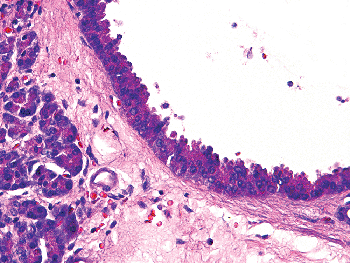 |
Figure 30.53 This small interlobular duct shows partial acinar metaplasia, with slightly enlarged acinar cells replacing the normal cuboidal ductal epithelium. |
Sometimes small ducts may demonstrate partial or complete replacement by acinar cells. When this process is very localized, it has been referred to as acinar metaplasia. However, larger neoplasms composed of cystic spaces lined by benign acinar cells, designated as acinar cell cystadenomas, have also been described (164), and the distinction of microscopic examples of this neoplasm (which represent a significant proportion of the reported cases) from acinar metaplasia is somewhat arbitrary. In acinar metaplasia the acinar cells occur singly or in clusters within the ducts, and they exhibit the same appearance as their normally situated counterparts (Figure 30.53). Immunohistochemical labeling for trypsin or chymotrypsin facilitates identification of acinar metaplasia, although the granular apical cytoplasmic staining of true acinar cells must be distinguished from the labeling of deposited intraluminal enzyme secretions on the surface of ductal cells (Figure 30.13).
Another frequent alteration of the ducts is ectasia. Ectatic ducts are generally (but not invariably) found in association with chronic pancreatitis in older patients (13,16,165), often due to ductal obstruction. The ectatic ducts range up to several millimeters in size and occasionally are recognizable grossly. Dilatation of the main pancreatic duct to more than 4 mm is found in 16% of patients at autopsy (13). Because ectatic ducts are often tortuous and the dilatation may be localized, they may appear as single or multiple small cysts (retention cysts) in cross section (Figure 30.54A). Careful study of serial sections shows the
P.749
continuity with the ductal system. Retention cysts are usually grossly evident and may reach several centimeters in diameter. The lining epithelium may harbor PanIN, usually PanIN-1 but sometimes higher grade lesions as well (Figure 30.54B). Retention cysts with PanIN may be difficult to distinguish from intraductal papillary mucinous neoplasms (IPMNs) (166,167,168,169,170), and attempts have been made to reach a consensus on diagnostic criteria (156). In general, multicystic lesions with micropapillae or true papillae are regarded as IPMNs, whereas solitary cysts with flat epithelium represent retention cysts with PanIN.
 |
Figure 30.54 Duct ectasia. The dilated ducts may be lined by a flattened cuboidal epithelium resembling normal ductal epithelium (A), or there may be involvement by PanIN (B). In the latter circumstance, the lesion merges morphologically with intraductal papillary-mucinous neoplasm. |
Islet Cells
Islet hyperplasia is defined as an absolute increase in the size or number of islets relative to the normal islet volume at a given age. Individual compact islets larger than 250 m in diameter are regarded to be hyperplastic (171). However, making an assessment that there is an increase in the total volume of islet tissue in the pancreas is difficult. There are a number of conditions, most associated with pancreatic atrophy, that can result in the appearance of increased numbers of islets when in fact the islet volume is not increased but rather the volume of exocrine elements has decreased (see below). Plus, the density of islets varies in different regions of the pancreas. Thus, some objective assessment of islet volume must be made for a diagnosis of islet hyperplasia, rather than just a casual observation of numerous islets. Conditions associated with islet hyperplasia in infancy include Beckwith-Wiedemann syndrome, maternal diabetes, erythroblastosis fetalis, and hyperinsulinemic hypoglycemia (55); cases have also been described in adults with hyperinsulinism (172). Islet hyperplasia may occur either by proliferation of islet cells or by neoformation of islet cells from uncommitted progenitors (42). The distribution of the different peptide cell types is usually maintained, although there may be a relative increase in the number of cells, some of which may show hypertrophy.
Nesidioblastosis is a descriptor of the morphologic findings accompanying functional disorders of cells associated with hyperinsulinemic hypoglycemia in the absence of an insulinoma (173,174,175,176). This condition generally occurs in neonates and infants, where it is known as persistent neonatal hyperinsulinemic hypoglycemia (PNHH); a similar condition occurs rarely in adults. Morphologic abnormalities include hypertrophic cells within the islets; close association of islet cells with small pancreatic ducts (ductuloinsular complexes), particularly in neonates; and abnormal aggregation of islets. Both focal and diffuse types are described (173). In focal nesidioblastosis, there is a localized nodular lesion that may resemble an insulinoma, but more often there is simply an aggregate of ill-formed isletlike clusters associated with small ductules (Figure 30.55).
P.750
Some of the nuclei within the lesion are enlarged. The islets in the remaining pancreas are normal. The diffuse form of nesidioblastosis shows islet abnormalities throughout the gland without discrete localized aggregation of islets. The principal finding is the presence of enlarged, hyperchromatic -cell nuclei. The size of nuclei in cells varies somewhat in normal neonates; but, in nesidioblastosis, there is a 40% increase in nuclear volume compared with age-matched controls. By immunohistochemistry, the islets in both focal and diffuse types of nesidioblastosis retain their normal complements of peptide cell types. Genetically, PNHH is associated with a number of different mutations in genes such as ABCC8 and KCNJ11 that encode the ATP-sensitive potassium channel (KATP) in the cell membrane of cells, demonstrating that this disorder clearly has a functional basis and does not simply reflect an increase in -cell mass (177,178,179,180).
 |
Figure 30.55 The pancreas from an infant with persistent neonatal hyperinsulinemic hypoglycemia shows the focal form of nesidioblastosis. There is localized aggregation of islets separated by thin bands of acini. |
The apparent increase in number of islets that occurs secondary to exocrine atrophy has been termed islet aggregation and is not a result of hyperplasia. With the progressive atrophy that occurs in chronic pancreatitis, eventually most of the acini and many of the ducts disappear, leaving only residual islets embedded in fibrous or adipose tissue (Figure 30.56) (140). This phenomenon may be widespread in patients with significant chronic pancreatitis, or it may only involve one lobule of the gland. In addition to the clustering of islets, some degree of islet cell proliferation may occur (181); however, islet aggregation should be distinguished from true islet cell hyperplasia. The clustering of islets in regions of severe atrophy may resemble a solid tumorlike process with a nesting pattern, reminiscent of a pancreatic endocrine neoplasm (Figure 30.57). Individual islets may be found in the peripancreatic adipose tissue. The appearance of infiltrative growth is even more marked when the process involves the regions of the head of the pancreas containing the diffuse islets; these islets lack the insular arrangement of the compact islets from the tail, appearing as small clusters, trabeculae, and individual cells when the exocrine elements undergo atrophy (Figure 30.58). In contrast to most pancreatic endocrine neoplasms, the border of foci of islet aggregation is ill defined. The surrounding pancreas often exhibits areas of pancreatitis that are less advanced, with incomplete acinar atrophy. In problematic cases, immunohistochemical labeling for the specific peptides may be helpful. In islet aggregation, the normal peptide cell types are present, in roughly normal numbers and distribution, although the relative proportions of and PP cells may be increased (106,181). Although more than one peptide may be expressed in endocrine neoplasms,
P.751
it is exceptional for all of the normal peptides to be found in normal numbers, and there may be expression of peptides not found in normal islets (vasoactive intestinal polypeptide or gastrin). Bear in mind that the diffuse islets have a different normal peptide cell constitution (abundance of PP cells) from that of the compact islets (Figure 30.59). Another pseudoneoplastic property of islet cells in chronic pancreatitis is perineural invasion (Figure 30.60). Small clusters of islet cells may surround nerves, simulating the perineural invasion that is so common in pancreatic ductal adenocarcinoma. Fortunately, benign glands only exceptionally rarely exhibit perineural invasion. Immunohistochemical labeling for chromogranin may be used to distinguish benign perineural invasion by islet cells from adenocarcinoma.
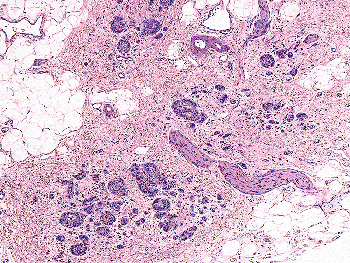 |
Figure 30.56 Islet aggregation involving compact islets. With extreme atrophy, there is complete loss of exocrine elements, leaving the clustered islets embedded in fibrous stroma. |
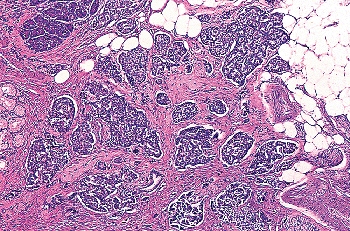 |
Figure 30.57 When advanced atrophy of exocrine elements occurs, aggregation of the remaining endocrine elements may simulate a neoplasm. The nests of cells may be poorly circumscribed and separated by bands of fibrous tissue, with extension into peripancreatic adipose tissue. |
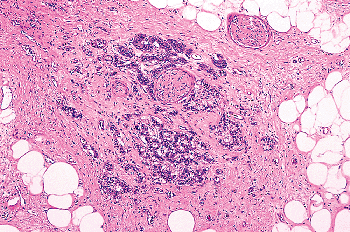 |
Figure 30.58 Exocrine atrophy in areas containing diffuse-type islets results in a pseudoinfiltrative pattern of individual cells and trabeculae. |
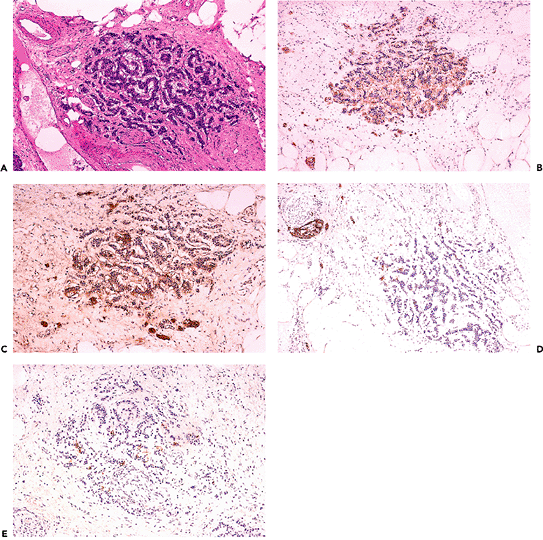 |
Figure 30.59 Immunohistochemistry may be helpful for distinguishing foci of islet aggregation from an endocrine neoplasm. In this focus (A) with a trabecular and infiltrative pattern, there is an abundance of PP cells (B) and cells (C), with smaller numbers of (D) and (E) cells, a composition typical of nonneoplastic diffuse type islets. |
The appearance of dilated blood-filled spaces within the islets (Figure 30.61) has been referred to as peliosis insulis. Although reported in a pancreas from a patient with
P.752
multiple endocrine neoplasia-I (MEN-I) and harboring multiple pancreatic endocrine neoplasms (182), peliosis insulis usually occurs in otherwise normal pancreata. It is of unclear etiology and significance. The blood-filled spaces are not observed to be lined by endothelium ultrastructurally.
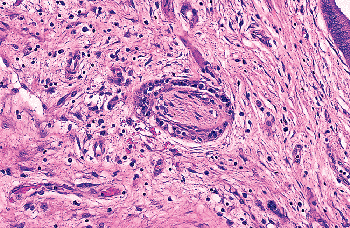 |
Figure 30.60 Perineural invasion by islet cells in chronic pancreatitis may simulate carcinoma. |
Perivascular deposition of amyloid or amyloid-like material may be seen in islets of older individuals (Figure 30.62), especially in association with non insulin-dependent (type II) diabetes mellitus (183). Insular amyloid is biochemically different from systemic amyloid, and there is no association between insular amyloidosis and systemic amyloidosis. In insular amyloidosis, the hyalinized stroma is limited to the islets. In patients with generalized fibrosis of the pancreatic parenchyma due to chronic pancreatitis or other causes, the islets also may be involved (insular fibrosis); however, the hyalinized stroma in these cases has no ultrastructural features of amyloid (183).
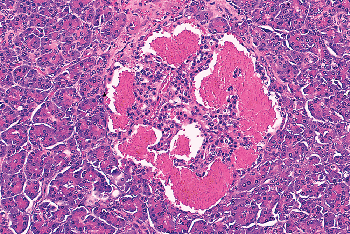 |
Figure 30.61 The appearance of dilated, blood-filled spaces within the islets has been called peliosis insulis. It is probably of no clinical significance. |
 |
Figure 30.62 Amyloid-like hyalinization of the perivascular tissue may be seen in the islets, especially in older patients with type II diabetes. The surrounding acinar tissue is not fibrotic. |
Chronic Pancreatitis, Atrophy, and Fibrosis
Several different types of chronic pancreatitis exist, with etiologies including chronic alcoholism, ductal obstruction, autoimmune disorders, malnutrition, and genetic predisposition (184,185,186,187,188,189,190). Although the distribution of the disease within the pancreas varies with the different types, the histologic features of most types (except for autoimmune pancreatitis) are similar, especially at the end stages when fibrosis and atrophy are prominent (16). In fact, microscopic foci of fibrosis and atrophy (histologic chronic pancreatitis) are common incidental findings in pancreatic resection specimens or at autopsy, and the pathologic findings often reported as focal chronic pancreatitis are only loosely related to the clinical disease of chronic pancreatitis.
When chronic pancreatitis is localized, it may mimic pancreatic carcinoma clinically, radiographically, and grossly, and the resultant histological patterns also frequently simulate neoplasia. Early in the process, the fibrosis is largely around the periphery of the lobules, there is minimal acinar atrophy, and chronic inflammatory cells are evident (Figure 30.63A). The glands may be enlarged. However, as chronic pancreatitis progresses, the fibrosis involves the entire lobule, with marked distortion of the architecture. There is progressive exocrine atrophy, with eventual complete loss of acinar elements. The ducts become ectatic and irregularly shaped (Figure 30.63B). Ultimately, even the ducts are lost, leaving only the islets. In experimental pancreatitis induced by duct ligation, acinar atrophy occurs by necrosis and apoptosis (191,192), resulting in closely packed lobules of ductular structures. Small ductules and islets remaining after acinar atrophy become encircled and distorted by the fibrous tissue (Figure 30.63C),
P.753
often acquiring a pseudoinfiltrative appearance. Ductuloinsular complexes may be found (Figure 30.64). As the gland is replaced by fibrous tissue, it decreases in size and acquires a woody consistency. Inflammatory cells are sparse at this stage and may be aggregated around small nerves (133). Duct ectasia, calcification, and intraductal calculi may occur (193), especially in pancreatitis of alcoholic etiology. The ducts may show PanIN, although the presence of intraepithelial neoplasia is not necessarily related to the chronic pancreatitis (142); and, other than the congenital type, chronic pancreatitis per se is only associated with a small increased risk for pancreatic cancer (194). It is possible that the chronic pancreatitis commonly accompanying ductal adenocarcinoma is secondary to ductal obstruction by the tumor rather than representing a preexisting condition.
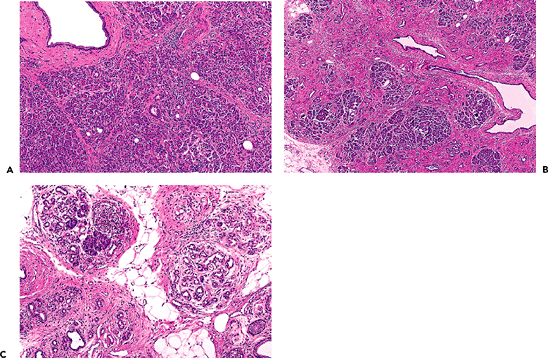 |
Figure 30.63 Progressive changes in chronic pancreatitis. A. In the early stages, the fibrosis is largely limited to the periductal and septal areas of the gland. The lobules show prominence of ductules. There are scattered aggregates of chronic inflammatory cells. B. As the pancreatitis progresses, the amount of fibrosis is increased, entrapping small lobules of residual acinar tissue. The ducts are ectatic. C. In the terminal stages, most of the acinar tissue is atrophic, leaving lobular aggregates of small ductules and islets within a fibrotic and fatty stroma. |
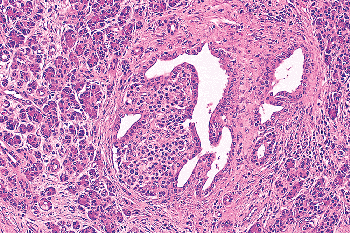 |
Figure 30.64 A ductuloinsular complex in an adult with mild chronic pancreatitis. Small ductules are surrounded by nests of endocrine cells, a finding that does not necessarily reflect true islet cell hyperplasia. |
The distinction of chronic pancreatitis from infiltrating ductal adenocarcinoma on the basis of biopsies can be very challenging. The distorted ducts and ductules in areas of fibrosis closely resemble the pattern of ductal adenocarcinoma, and the fibrotic stroma may simulate the desmoplastic stroma often accompanying carcinoma. Features that support the interpretation of chronic pancreatitis include a retention of the lobular arrangement of the small collections of ductules, normal location of the glands, and uniformity of nuclear morphology from one cell to the next (Figures 30.65A C). Features that conversely favor the diagnosis of carcinoma include haphazardly arranged individual angulated glands infiltrating the
P.754
P.755
stroma, glands in abnormal locations [adjacent to muscular arteries (122), in the perineurium, within vessels, or immediately apposed to adipocytes], significant cytological abnormalities (variation in shape and size of nuclei from one cell to the next, macronucleoli, loss of nuclear polarity), and individual cells or small cell clusters in the stroma (Figures 30.65D F, 30.66). It is helpful when two cytologically distinct populations of cells are found in the biopsy, since some of nuclear features of well-differentiated carcinomas are very subtle unless compared with a second population of clearly benign glands. Unfortunately, biopsy samples of the pancreas are frequently small, and it is uncommon for all of the characteristic features to be present. Even if carcinoma is present, it may only be represented by two or three glands. Furthermore, needle biopsy samples are sometimes subjected to frozen section examination, which may introduce artifacts complicating the interpretation. Even for the experienced observer, there may be cases having rare atypical glands that cannot be confidently diagnosed as benign or malignant. Performance of serial sections sometimes reveals additional diagnostic features. Immunohistochemistry also can be useful to document some of the abnormalities characteristic of carcinoma. Most benign glands do not express CEA, B72.3, CA125, or p53 at immunohistochemically detectable levels (92), and they will all show normal intact labeling for the Dpc4 protein. By contrast, most pancreatic cancers express CEA, 75% label for B72.3, 50 to 75% for p53, 45% for CA125, and 55% show complete loss of Dpc4 expression (Figure 30.67) (195). Expression of mesothelin also supports a diagnosis of carcinoma (196).
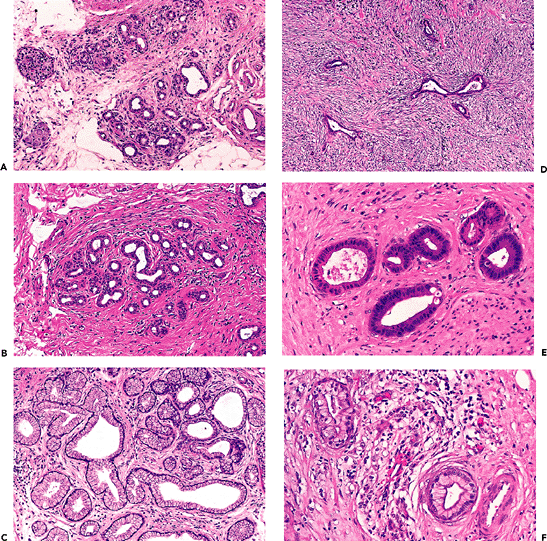 |
Figure 30.65 Comparison of ductules in atrophic chronic pancreatitis with well-differentiated ductal adenocarcinoma. A. In chronic pancreatitis, there is preservation of the lobular arrangement of small ductules, with larger branching ductules surrounded by collections of smaller tubular glands. Some residual islets of Langerhans are also present. B. At higher power, the cells are generally uniform, with round nuclei having a similar cytologic appearance from cell to cell. C. In areas showing mucinous metaplasia, there may not be as obvious a lobular arrangement. However, the glands retain a benign cytologic appearance and have uniformly basally oriented nuclei. D. In infiltrating adenocarcinoma, the lobular arrangement of the glands is lost. There is a haphazard configuration of angulated glands within a desmoplastic stroma. E. In some instances, there may not be significant stromal desmoplasia, and the glands may retain rounded contours. However, there is variability in cytologic appearance from one cell to the next, with occasional macronucleoli, loss of polarity, and mitotic figures. F. Some individual glands of infiltrating carcinoma may be almost impossible to distinguish from benign ductules. This remarkably well-differentiated gland (lower right) contrasts with an adjacent gland showing marked loss of nuclear polarity. The abnormal location of the gland adjacent to a muscular artery is another clue that it is malignant. |
 |
Figure 30.66 It is helpful to identify two populations of cells in specimens harboring an infiltrating adenocarcinoma. In this example, a lobular collection of benign ductules contrasts with irregularly shaped glands of adenocarcinoma. |
Atrophy of pancreatic parenchyma due to long-standing ductal obstruction is often associated with infiltration by adipose tissue. Only rare islets may be found between lobules of fat in extreme cases (Figure 30.68). A primary form of fatty infiltration is Shwachman syndrome, an extremely rare autosomal recessive syndrome affecting the pancreas, bone marrow, and skeleton (197). An enlarged gland may result, but the amount of parenchymal tissue is reduced and exocrine insufficiency is present (16). The term lipomatosis has been applied to pancreata containing more than 25% adipose tissue (Figure 30.69). The distribution of the adipose tissue is generally not uniform. Lipomatosis is usually associated with parenchymal atrophy and is more common in older individuals (13). Other associations include adult-onset diabetes and generalized atherosclerosis, conditions that are also more prevalent in the elderly. Pancreatic lipomatosis is not associated with generalized obesity (13).
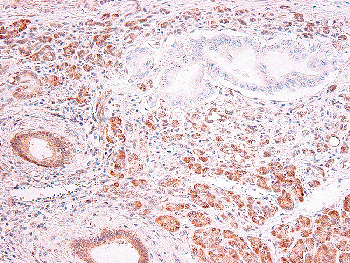 |
Figure 30.67 Immunohistochemisty for Dpc4 shows both nuclear and cytoplasmic labeling in normal acini and ducts, whereas the invasive carcinoma has complete absence of labeling. |
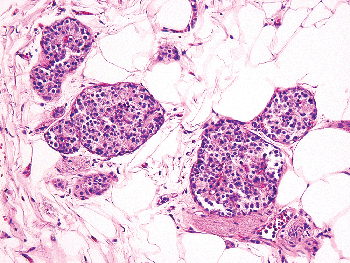 |
Figure 30.68 With extreme atrophy, the residual islets of Langerhans may be completely surrounded by adipose tissue. |
 |
Figure 30.69 In pancreatic lipomatosis, adipose tissue comprises more than 25% of the volume of the gland. As in this case, the remaining parenchyma may not necessarily show changes of atrophic chronic pancreatitis. |
P.756
References
1. Fawcett DW. Bloom and Fawcett: A Textbook of Histology. 12th ed. New York: Chapman & Hall; 1994.
2. Moore KL. Clinically Oriented Anatomy. Baltimore: Williams & Wilkins; 1980.
3. Lack EE. Pathology of the Pancreas, Gallbladder, Extrahepatic Biliary Tract, and Ampullary Region. New York: Oxford University Press; 2003.
4. Skandalakis LJ, Rowe JS Jr, Gray SW, Skandalakis JE. Surgical embryology and anatomy of the pancreas. Surg Clin North Am 1993;73:661 697.
5. Pansky B. Anatomy of the pancreas. Emphasis on blood supply and lymphatic drainage. Int J Pancreatol 1990;7:101 108.
6. Bockman DE. Anatomy of the pancreas. In: Go VL, Brooks FP, DiMagno EP, Gardner JD, Lebenthal E, Scheele GA, eds. The Exocrine Pancreas: Biology, Pathobiology and Diseases. New York: Raven Press; 1986:1 7.
7. Ibukuro K. Vascular anatomy of the pancreas and clinical applications. Int J Gastrointest Cancer 2001;30:87 104.
8. Navas V, O'Morchoe PJ, O'Morchoe CC. Lymphatic system of the rat pancreas. Lymphology 1995;28:4 20.
9. Cubilla AL, Fortner J, Fitzgerald PJ. Lymph node involvement in carcinoma of the head of the pancreas area. Cancer 1978;41:880 887.
10. Deki H, Sato T. An anatomic study of the peripancreatic lymphatics. Surg Radiol Anat 1988;10:121 135.
11. Evans BP, Ochsner A. The gross anatomy of the lymphatics of the human pancreas. Surgery 1954;36:177 191.
12. Nagakawa T, Kobayashi H, Ueno K, et al. The pattern of lymph node involvement in carcinoma of the head of the pancreas. A histologic study of the surgical findings in patients undergoing extensive nodal dissections. Int J Pancreatol 1993;13:15 22.
13. Stamm BH. Incidence and diagnostic significance of minor pathologic changes in the adult pancreas at autopsy: a systematic study of 112 autopsies in patients without known pancreatic disease. Hum Pathol 1984;15:677 683.
14. Heitz PU, Beglinger C, Gyr K. Anatomy and physiology of the exocrine pancreas. In: Kloeppel G, Heitz PU, eds. Pancreatic Pathology. New York: Churchill-Livingstone; 1984:3 21.
15. Birnstingl M. A study of pancreaticography. Br J Surg 1959;47:128 139.
16. Cubilla AL, Fitzgerald PJ. Tumors of the exocrine pancreas. In: Hartmann WH, Sobin LH, eds. Atlas of Tumor Pathology. 2nd series, fascicle 19. Washington, DC: Armed Forces Institute of Pathology; 1984.
17. Kozu T, Suda K, Toki F. Pancreatic development and anatomical variation. Gastrointest Endosc Clin N Am 1995;5:1 30.
18. Baggenstoss AH. Major duodenal papilla. Variations of pathologic interest and lesions of mucosa. Arch Pathol 1938;26:853 868.
19. DiMagno EP, Shorter RG, Taylor WF, Go VL. Relationships between pancreaticobiliary ductal anatomy and pancreatic ductal and parenchymal histology. Cancer 1982;49:361 368.
20. Flati G, Flati D, Porowska B, Ventura T, Catarci M, Carboni M. Surgical anatomy of the papilla of Vater and biliopancreatic ducts. Am Surg 1994;60:712 718.
21. Frierson HF Jr. The gross anatomy and histology of the gallbladder, extrahepatic bile ducts, Vaterian system, and minor papilla. Am J Surg Pathol 1989;13:146 162.
22. Corliss CE. Patten's Human Embryology: Elements of Clinical Development. New York: McGraw-Hill; 1976.
23. Lebenthal E, Lev R, Lee PC. Prenatal and postnatal development of the human exocrine pancreas. In: Go VL, Brooks FP, DiMagno EP, Garder, Lebenthal E, Scheele GA, eds. The Exocrine Pancreas: Biology, Pathobiology, and Diseases. New York: Raven Press; 1986:33 43.
24. Edlund H. Pancreas: how to get there from the gut? Curr Opin Cell Biol 1999;11:663 668.
25. Ahlgren U, Jonsson J, Edlund H. The morphogenesis of the pancreatic mesenchyme is uncoupled from that of the pancreatic epithelium in IPF1/PDX1-deficient mice. Development 1996;122:1409 1416.
26. Song SY, Gannon M, Washington MK, et al. Expansion of Pdx1-expressing pancreatic epithelium and islet neogenesis in transgenic mice overexpressing transforming growth factor alpha. Gastroenterology 1999;117:1416 1426.
27. Gradwohl G, Dierich A, LeMeur M, Guillemot F. Neurogenin3 is required for the development of the four endocrine cell lineages of the pancreas. Proc Natl Acad Sci U S A 2000;97:1607 1611.
28. Murtaugh LC, Melton DA. Genes, signals, and lineages in pancreas development. Annu Rev Cell Dev Biol 2003;19:71 89.
29. Naya FJ, Huang HP, Qiu Y, et al. Diabetes, defective pancreatic morphogenesis, and abnormal enteroendocrine differentiation in BETA2/neuroD-deficient mice. Genes Dev 1997;11:2323 2334.
30. Schwitzgebel VM, Scheel DW, Conners JR, et al. Expression of neurogenin3 reveals an islet cell precursor population in the pancreas. Development 2000;127:3533 3542.
31. Krapp A, Knofler M, Ledermann B, et al. The bHLH protein PTF1-p48 is essential for the formation of the exocrine and the correct spatial organization of the endocrine pancreas. Genes Dev 1998;12:3752 3763.
32. Murtaugh LC, Stanger BZ, Kwan KM, Melton DA. Notch signaling controls multiple steps of pancreatic differentiation. Proc Natl Acad Sci U S A 2003;100:14920 14925.
33. Hebrok M. Hedgehog signaling in pancreas development. Mech Dev 2003;120:45 57.
34. Conklin JL. Cytogenesis of the human fetal pancreas. Am J Anat 1962;111:181 193.
35. Chong JM, Fukayama M, Shiozawa Y, et al. Fibrillary inclusions in neoplastic and fetal acinar cells of the pancreas. Virchows Arch 1996;428:261 266.
36. Laitio M, Lev R, Orlic D. The developing human fetal pancreas: an ultrastructural and histochemical study with special reference to exocrine cells. J Anat 1974;117(pt 3):619 634.
37. Hassan MO, Gogate PA. Malignant mixed exocrine-endocrine tumor of the pancreas with unusual intracytoplasmic inclusions. Ultrastruct Pathol 1993;17:483 493.
38. Klimstra DS, Heffess CS, Oertel JE, Rosai J. Acinar cell carcinoma of the pancreas. A clinicopathologic study of 28 cases. Am J Surg Pathol 1992;16:815 837.
39. Klimstra DS, Rosai J, Heffess CS. Mixed acinar-endocrine carcinomas of the pancreas. Am J Surg Pathol 1994;18:765 778.
40. Klimstra DS, Wenig BM, Adair CF, Heffess CS. Pancreatoblastoma. A clinicopathologic study and review of the literature. Am J Surg Pathol 1995;19:1371 1389.
41. Tucker JA, Shelburne JD, Benning TL, Yacoub L, Federman M. Filamentous inclusions in acinar cell carcinoma of the pancreas. Ultrastruct Pathol 1994;18:279 286.
42. Kloppel G, Lenzen S. Anatomy and physiology of the endocrine pancreas. In: Kloppel G, Heitz PU, eds. Pancreatic Pathology. New York: Churchill-Livingstone; 1984:133 153.
P.757
43. Robb P. The development of the islets of Langerhans in the human foetus. Q J Exp Physiol Cogn Med Sci 1961;46:335 343.
44. Clark A, Grant AM. Quantitative morphology of endocrine cells in human fetal pancreas. Diabetologia 1983;25:31 35.
45. Grasso S, Palumbo G, Fallucca F, Lanzafame S, Indelicato B, Sanfilippo S. The development and function of the endocrine pancreas of fetuses and infants born to normal and diabetic mothers. Acta Endocrinol Suppl (Copenh) 1986;277:130 135.
46. Albores-Saavedra J, Gould EW, Angeles-Angeles A, Henson DE. Cystic tumors of the pancreas. Pathol Annu 1990;25(pt 2):19 50.
47. Compagno J, Oertel JE. Mucinous cystic neoplasms of the pancreas with overt and latent malignancy (cystadenocarcinoma and cystadenoma). A clinicopathologic study of 41 cases. Am J Clin Pathol 1978;69:573 580.
48. Stoffers DA, Zinkin NT, Stanojevic V, Clarke WL, Habener JF. Pancreatic agenesis attributable to a single nucleotide deletion in the human IPF1 gene coding sequence. Nat Genet 1997;15:106 110.
49. Kiernan PD, ReMine SG, Kiernan PC, ReMine WH. Annular pancreas: May Clinic experience from 1957 to 1976 with review of the literature. Arch Surg 1980;115:46 50.
50. Lloyd-Jones W, Mountain JC, Warren KW. Annular pancreas in the adult. Ann Surg 1972;176:163 170.
51. Newman BM, Lebenthal E. Congenital abnormalities of the exocrine pancreas. In: Go VL, Brooks FP, DiMagno EP, Gardner JD, Lebenthal E, Scheele GA, eds. The Exocrine Pancreas: Biology, Pathobiology, and Diseases. New York: Raven Press; 1986:773 782.
52. England RE, Newcomer MK, Leung JW, et al. Case report: annular pancreas divisum a report of two cases and review of the literature. Br J Radiol 1995;68:324 328.
53. Ravitch MM, Woods AC Jr. Annular pancreas. Ann Surg 1950;132:1116 1127.
54. Dowsett JF, Rode J, Russell RC. Annular pancreas: a clinical, endoscopic, and immunohistochemical study. Gut 1989;30:130 135.
55. Solcia E, Capella C, Kloppel G. Tumors of the pancreas. In: Rosai J, Sobin LH, eds. Atlas of Tumor Pathology. 3rd series, fascicle 20. Washington, DC: Armed Forces Institute of Pathology; 1996.
56. Dawson W, Langman J. An anatomical-radiological study on the pancreatic duct pattern in man. Anat Rec 1961;139:59 68.
57. Cotton PB. Pancreas divisum. Pancreas 1988;3:245 247.
58. Stern CD. A historical perspective on the discovery of the accessory duct of the pancreas, the ampulla of Vater and pancreas divisum. Gut 1986;27:203 212.
59. Leese T, Chiche L, Bismuth H. Pancreatitis caused by congenital anomalies of the pancreatic ducts. Surgery 1989;105(pt 1):125 130.
60. Kimura K, Ohto M, Saisho H, et al. Association of gallbladder carcinoma and anomalous pancreaticobiliary ductal union. Gastroenterology 1985;89:1258 1265.
61. Kinoshita H, Nagata E, Hirohashi K, Sakai K, Kobayashi Y. Carcinoma of the gallbladder with an anomalous connection between the choledochus and the pancreatic duct. Report of 10 cases and review of the literature in Japan. Cancer 1984;54:762 769.
62. Krishnamurty VS, Rajendran S, Korsten MA. Bifid pancreas. An unusual anomaly associated with acute pancreatitis. Int J Pancreatol 1994;16:179 181.
63. Pang LC. Pancreatic heterotopia: a reappraisal and clinicopathologic analysis of 32 cases. South Med J 1988;81:1264 1275.
64. Barbosa J, Dockerty MB, Waugh JM. Pancreatic heterotropia: surgical cases. Proc Mayo Clin 1946;21:246 255.
65. Lai EC, Tompkins RK. Heterotopic pancreas. Review of a 26 year experience. Am J Surg 1986;151:697 700.
66. Dolan RV, ReMine WH, Dockerty MB. The fate of heterotopic pancreatic tissue. A study of 212 cases. Arch Surg 1974;109:762 765.
67. Laughlin EH, Keown ME, Jackson JE. Heterotopic pancreas obstructing the ampulla of Vater. Arch Surg 1983;118:979 980.
68. Tsunoda T, Eto T, Yamada M, et al. Heterotopic pancreas: a rare cause of bile duct dilatation report of a case and review of the literature. Jpn J Surg 1990;20:217 220.
69. Seifert G. Congenital anomalies. In: Kloppel G, Heitz PU, eds. Pancreatic Pathology. New York: Churchill-Livingstone; 1984:22 26.
70. Goldfarb WB, Bennett D, Monafo W. Carcinoma in heterotopic gastric pancreas. Ann Surg 1963;158:56 58.
71. Persson GE, Boiesen PT. Cancer of aberrant pancreas in jejunum. Case report. Acta Chir Scand 1988;154:599 601.
72. Tanimura A, Yamamoto H, Shibata H, Sano E. Carcinoma in heterotopic gastric pancreas. Acta Pathol Jpn 1979;29:251 257.
73. Landry ML, Sarma DP. Accessory spleen in the head of the pancreas. Hum Pathol 1989;20:497.
74. Albores-Saavedra J. The pseudometastasis. Patologia (Mex) 1994;32:63 71.
75. Akao S, Bockman DE, Lechene de la Porte P, Sarles H. Three-dimensional pattern of ductuloacinar associations in normal and pathological human pancreas. Gastroenterology 1986;90:661 668.
76. Henderson JR, Daniel PM, Fraser PA. The pancreas as a single organ: the influence of the endocrine upon the exocrine part of the gland. Gut 1981;22:158 167.
77. Williams JA, Goldfine ID. The insulin-acinar relationship. In: Go VL, Brooks FP, DiMagno EP, Gardner JD, Lebenthal E, Scheele GA, eds. The Exocrine Pancreas: Biology, Pathobiology, and Diseases. New York: Raven Press; 1986:347 360.
78. Hoorens A, Lemoine NR, McLellan E, et al. Pancreatic acinar cell carcinoma. An analysis of cell lineage markers, p53 expression, and Ki-ras mutation. Am J Pathol 1993;143:685 698.
79. Bendayan M, Roth J, Perrelet A, Orci L. Quantitative immunocytochemical localization of pancreatic secretory proteins in subcellular compartments of the rat acinar cell. J Histochem Cytochem 1980;28:149 160.
80. Kraehenbuhl JP, Racine L, Jamieson JD. Immunocytochemical localization of secretory proteins in bovine pancreatic exocrine cells. J Cell Biol 1977;72:406 423.
81. Kern HF. Fine structure of the human exocrine pancreas. In: Go VL, Brooks FP, DiMagno EP, Gardner JD, Lebenthal E, Scheele GA, eds. The Exocrine Pancreas: Biology, Pathobiology, and Diseases. New York: Raven Press; 1986:9 19.
82. Palade G. Intracellular aspects of the process of protein synthesis. Science 1975;189:347 358.
83. Romagnoli P. Increases in apical plasma membrane surface paralleling enzyme secretion from exocrine pancreatic acinar cells. Pancreas 1988;3:189 192.
84. Kodama T. A light and electron microscopic study on the pancreatic ductal system. Acta Pathol Jpn 1983;33:297 321.
85. Greider MH. Oxyphil cells of the human pancreas. Anat Rec 1967;157:251.
86. Roberts PF, Burns J. A histochemical study of mucins in normal and neoplastic human pancreatic tissue. J Pathol 1972;107:87 94.
87. Schulz I. Electrolyte and fluid secretion in the exocrine pancreas. In: Johnson LR, ed. Physiology of the Gastrointestinal Tract. Vol 2. New York: Raven Press; 1981:795 819.
88. Spicer SS, Sens MA, Tashian RE. Immunocytochemical demonstration of carbonic anhydrase in human epithelial cells. J Histochem Cytochem 1982;30:864 873.
89. Atkinson BF, Ernst CS, Herlyn M, Steplewski Z, Sears HF, Koprowski H. Gastrointestinal cancer-associated antigen in immunoperoxidase assay. Cancer Res 1982;42:4820 4823.
90. Borowitz MJ, Tuck FL, Sindelar WF, Fernsten PD, Metzgar RS. Monoclonal antibodies against human pancreatic adenocarcinoma: distribution of DU-PAN-2 antigen on glandular epithelia and adenocarcinomas. J Natl Cancer Inst 1984;72:999 1005.
91. Haglund C, Lindgren J, Roberts PJ, Nordling S. Gastrointestinal cancer-associated antigen CA 19-9 in histological specimens of pancreatic tumours and pancreatitis. Br J Cancer 1986;53:189 195.
92. Klimstra DS, Hameed MR, Marrero AM, Conlon KC, Brennan MF. Ductal proliferative lesions associated with infiltrating ductal adenocarcinoma of the pancreas. Int J Pancreatol 1994;16:224 225.
93. Sessa F, Bonato M, Frigerio B, et al. Ductal cancers of the pancreas frequently express markers of gastrointestinal epithelial cells. Gastroenterology 1990;98:1655 1665.
94. Kim JH, Ho SB, Montgomery CK, Kim YS. Cell lineage markers in human pancreatic cancer. Cancer 1990;66:2134 2143.
95. Balague C, Gambus G, Carrato C, et al. Altered expression of MUC2, MUC4, and MUC5 mucin genes in pancreas tissues and cancer cell lines. Gastroenterology 1994;106:1054 1061.
96. Terada T, Ohta T, Sasaki M, Nakanuma Y, Kim YS. Expression of MUC apomucins in normal pancreas and pancreatic tumours. J Pathol 1996;180:160 165.
P.758
97. Rahier J, Wallon J, Henquin JC. Cell populations in the endocrine pancreas of human neonates and infants. Diabetologia 1981;20:540 546.
98. Wittingen J, Frey CF. Islet concentration in the head, body, tail and uncinate process of the pancreas. Ann Surg 1974;179:412 414.
99. Stefan Y, Grasso S, Perrelet A, Orci L. A quantitative immunofluorescent study of the endocrine cell populations in the developing human pancreas. Diabetes 1983;32:293 301.
100. Grube D, Bohn R. The microanatomy of human islets of Langerhans, with special reference to somatostatin (D-) cells. Arch Histol Jpn 1983;46:327 353.
101. Malaisse-Lagae F, Stefan Y, Cox J, Perrelet A, Orci L. Identification of a lobe in the adult human pancreas rich in pancreatic polypeptide. Diabetologia 1979;17:361 365.
102. Stefan Y, Grasso S, Perrelet A, Orci L. The pancreatic polypeptide-rich lobe of the human pancreas: definitive identification of its derivation from the ventral pancreatic primordium. Diabetologia 1982;23:141 142.
103. Ehrie MG, Swartz FJ. Diploid, tetraploid and octaploid beta cells in the islets of Langerhans of the normal human pancreas. Diabetes 1974;23:583 588.
104. Lecompte PM, Merriam JC Jr. Mitotic figures and enlarged nuclei in the Islands of Langerhans in man. Diabetes 1962;11:35 39.
105. Pelletier G. Identification of four cell types in the human endocrine pancreas by immunoelectron microscopy. Diabetes 1977;26:749 756.
106. Bommer G, Friedl U, Heitz PU, Kloppel G. Pancreatic PP cell distribution and hyperplasia. Immunocytochemical morphology in the normal human pancreas, in chronic pancreatitis and pancreatic carcinoma. Virchows Arch A Pathol Anat Histol 1980;387:319 331.
107. Orci L, Baetens D, Ravazzola M, Stefan Y, Malaisse-Lagae F. Pancreatic polypeptide and glucagon: non-random distribution in pancreatic islets. Life Sci 1976;19:1811 1815.
108. Orci L, Malaisse-Lagae F, Baetens D, Perrelet A. Pancreatic-polypeptide-rich regions in human pancreas. Lancet 1978;2:1200 1201.
109. Orci L, Stefan Y, Malaisse-Lagae F, Perrelet A. Instability of pancreatic endocrine cell populations throughout life. Lancet 1979;1:615 616.
110. Fellinger EJ, Garin-Chesa P, Triche TJ, Huvos AG, Rettig WJ. Immunohistochemical analysis of Ewing's sarcoma cell surface antigen p30/32MIC2. Am J Pathol 1991;139:317 325.
111. Hochwald SN, Zee S, Conlon KC, et al. Prognostic factors in pancreatic endocrine neoplasms: an analysis of 136 cases with a proposal for low-grade and intermediate-grade groups. J Clin Oncol 2002;20:2633 2642.
112. Weidner N, Tjoe J. Immunohistochemical profile of monoclonal antibody O13: antibody that recognizes glycoprotein p30/32MIC2 and is useful in diagnosing Ewing's sarcoma and peripheral neuroepithelioma. Am J Surg Pathol 1994;18:486 494.
113. Kloppel G. Endokrines pankreas und diabetes mellitus. In: Doerr W, Seifert G, eds. Spezielle Pathologische Anatomie. Vol 14. Berlin: Springer; 1981:523 728.
114. Chen J, Baithun SI, Pollock DJ, Berry CL. Argyrophilic and hormone immunoreactive cells in normal and hyperplastic pancreatic ducts and exocrine pancreatic carcinoma. Virchows Arch A Pathol Anat Histopathol 1988;413:399 405.
115. Bendayan M. Presence of endocrine cells in pancreatic ducts. Pancreas 1987;2:393 397.
116. Oertel JE, Heffess CS, Oertel YC. Pancreas. In: Sternberg SS, ed. Histology for Pathologists. New York: Raven Press; 1992:657 668.
117. Patchefsky AS, Solit R, Phillips LD, et al. Hydroxyindole-producing tumors of the pancreas. Carcinoid-islet cell tumor and oat cell carcinoma. Ann Intern Med 1972;77:53 61.
118. Wilson RW, Gal AA, Cohen C, DeRose PB, Millikan WJ. Serotonin immunoreactivity in pancreatic endocrine neoplasms (carcinoid tumors). Mod Pathol 1991;4:727 732.
119. Chey WY. Hormonal control of pancreatic exocrine secretion. In: Go VL, Brooks FP, DiMagno EP, Gardner JD, Lebenthal E, Scheele GA, eds. The Exocrine Pancreas: Biology, Pathobiology, and Diseases. New York: Raven Press; 1986:301 313.
120. Henderson JR, Daniel PM. A comparative study of the portal vessels connecting the endocrine and exocrine pancreas, with a discussion of some functional implications. Q J Exp Physiol Cogn Med Sci 1979;64:267 275.
121. Adeghate E, Donath T. Distribution of neuropeptide Y and vasoactive intestinal polypeptide immunoreactive nerves in normal and transplanted pancreatic tissue. Peptides 1990;11:1087 1092.
122. Sharma S, Green KB. The pancreatic duct and its arteriovenous relationship: an underutilized aid in the diagnosis and distinction of pancreatic adenocarcinoma from pancreatic intraepithelial neoplasia. A study of 126 pancreatectomy specimens. Am J Surg Pathol 2004;28:613 620.
123. Olsen TS. Lipomatosis of the pancreas in autopsy material and its relation to age and overweight. Acta Pathol Microbiol Scand A 1978;86A:367 373.
124. Orci L, Stefan Y, Malaisse-Lagae F, Perrelet A, Patel Y. Pancreatic fat. N Engl J Med 1979;301:1292.
125. Suda K, Mizuguchi K, Hoshino A. Differences of the ventral and dorsal anlagen of pancreas after fusion. Acta Pathol Jpn 1981;31:583 589.
126. Jaster R. Molecular regulation of pancreatic stellate cell function. Mol Cancer 2004;3:26.
127. Popescu LM, Hinescu ME, Ionescu N, Ciontea SM, Cretoiu D, Ardelean C. Interstitial cells of Cajal in pancreas. J Cell Mol Med 2005;9:169 190.
128. Centeno BA, Pitman MB. Neoplasms of the exocrine and endocrine pancreas. In: Centeno BA, Pitman MB, eds. Fine Needle Aspiration Biopsy of the Pancreas. Boston: Butterworth-Heinemann; 1999:109 160.
129. Hruban RH, Pitman MB, Klimstra DS. Tumors of the pancreas. In: Silverberg SG, Sobin LH, eds. Atlas of Tumor Pathology. 4th series. Washington, DC: Armed Forces Institute of Pathology; 2006.
130. Shinozuka H, Lee RE, Dunn JL, Longnecker DS. Multiple atypical acinar cell nodules of the pancreas. Hum Pathol 1980;11:389 391.
131. Tanaka T, Mori H, Williams GM. Atypical and neoplastic acinar cell lesions of the pancreas in an autopsy study of Japanese patients. Cancer 1988;61:2278 2285.
132. Longnecker DS, Hashida Y, Shinozuka H. Relationship of age to prevalence of focal acinar cell dysplasia in the human pancreas. J Natl Cancer Inst 1980;65:63 66.
133. Oertel JE. The pancreas. Nonneoplastic alterations. Am J Surg Pathol 1989;13(suppl 1):50 65.
134. Longnecker DS, Shinozuka H, Dekker A. Focal acinar cell dysplasia in human pancreas. Cancer 1980;45:534 540.
135. Kodama T, Mori W. Atypical acinar cell nodules of the human pancreas. Acta Pathol Jpn 1983;33:701 714.
136. Baggenstoss AH. The pancreas in uremia: a histopathologic study. Am J Pathol 1948;24:1003 1017.
137. Walters MN. Studies on the exocrine pancreas. I. nonspecific pancreatic ductular ectasia. Am J Pathol 1964;44:973 981.
138. Walters MN. Goblet-cell metaplasia in ductules and acini of the exocrine pancreas. J Pathol Bacteriol 1965;89:569 572.
139. Schmid RM. Acinar-to-ductal metaplasia in pancreatic cancer development. J Clin Invest 2002;109:1403 1404.
140. Bockman DE, Boydston WR, Anderson MC. Origin of tubular complexes in human chronic pancreatitis. Am J Surg 1982;144:243 249.
141. Cubilla AL, Fitzgerald PJ. Morphological lesions associated with human primary invasive nonendocrine pancreas cancer. Cancer Res 1976;36(pt 2):2690 2698.
142. Kloppel G, Bommer G, Ruckert K, Seifert G. Intraductal proliferation in the pancreas and its relationship to human and experimental carcinogenesis. Virchows Arch A Pathol Anat Histol 1980; 387:221 233.
143. Roberts PF. Pyloric gland metaplasia of the human pancreas. A comparative histochemical study. Arch Pathol 1974;97:92 95.
144. Allen-Mersh TG. Pancreatic ductal mucinous hyperplasia: distribution within the pancreas, and effect of variation in ampullary and pancreatic duct anatomy. Gut 1988;29:1392 1396.
145. Mukada T, Yamada S. Dysplasia and carcinoma in situ of the exocrine pancreas. Tohoku J Exp Med 1982;137:115 124.
146. Brat DJ, Lillemoe KD, Yeo CJ, Warfield PB, Hruban RH. Progression of pancreatic intraductal neoplasias to infiltrating adenocarcinoma of the pancreas. Am J Surg Pathol 1998;22:163 169.
P.759
147. Goggins M, Hruban RH, Kern SE. BRCA2 is inactivated late in the development of pancreatic intraepithelial neoplasia: evidence and implications. Am J Pathol 2000;156:1767 1771.
148. Maitra A, Adsay NV, Argani P, et al. Multicomponent analysis of the pancreatic adenocarcinoma progression model using a pancreatic intraepithelial neoplasia tissue microarray. Mod Pathol 2003;16:902 912.
149. Moskaluk CA, Hruban RH, Kern SE. p16 and K-ras gene mutations in the intraductal precursors of human pancreatic adenocarcinoma. Cancer Res 1997;57:2140 2143.
150. van Heek NT, Meeker AK, Kern SE, et al. Telomere shortening is nearly universal in pancreatic intraepithelial neoplasia. Am J Pathol 2002;161:1541 1547.
151. Wilentz RE, Iacobuzio-Donahue CA, Argani P, et al. Loss of expression of Dpc4 in pancreatic intraepithelial neoplasia: evidence that DPC4 inactivation occurs late in neoplastic progression. Cancer Res 2000;60:2002 2006.
152. Klimstra DS, Longnecker DS. K-ras mutations in pancreatic ductal proliferative lesions. Am J Pathol 1994;145:1547 1550.
153. Kozuka S, Sassa R, Taki T, et al. Relation of pancreatic duct hyperplasia to carcinoma. Cancer 1979;43:1418 1428.
154. Pour PM, Sayed S, Sayed G. Hyperplastic, preneoplastic and neoplastic lesions found in 83 human pancreases. Am J Clin Pathol 1982;77:137 152.
155. Hruban RH, Adsay NV, Albores-Saavedra J, et al. Pancreatic intraepithelial neoplasia: a new nomenclature and classification system for pancreatic duct lesions. Am J Surg Pathol 2001;25:579 586.
156. Hruban RH, Takaori K, Klimstra DS, et al. An illustrated consensus on the classification of pancreatic intraepithelial neoplasia and intraductal papillary mucinous neoplasms. Am J Surg Pathol 2004;28:977 987.
157. Klein WM, Hruban RH, Klein-Szanto AJ, Wilentz RE. Direct correlation between proliferative activity and dysplasia in pancreatic intraepithelial neoplasia (PanIN): additional evidence for a recently proposed model of progression. Mod Pathol 2002;15:441 447.
158. Tasso F, Picard D. Sur les oncocytes du pancreas humain. C R Soc Biol (Paris) 1969;163:1855 1858.
159. Tasso F, Sarles H. Canalicular cells and oncocytes in the human pancreas. Comparative study on the normal condition and in chronic pancreatitis [article in French]. Ann Anat Pathol (Paris) 1973;18:277 300.
160. Frexinos J, Ribet A. Oncocytes in human chronic pancreatitis. Digestion 1972;7:294 301.
161. Albores-Saavedra J, Wu J, Crook T, Amirkhan RH, Jones L, Hruban RH. Intestinal and oncocytic variants of pancreatic intraepithelial neoplasia. A morphological and immunohistochemical study. Ann Diagn Pathol 2005;9:69 76.
162. Adsay NV, Merati K, Andea A, et al. The dichotomy in the preinvasive neoplasia to invasive carcinoma sequence in the pancreas: differential expression of MUC1 and MUC2 supports the existence of two separate pathways of carcinogenesis. Mod Pathol 2002;15:1087 1095.
163. Adsay NV, Merati K, Basturk O, et al. Pathologically and biologically distinct types of epithelium in intraductal papillary mucinous neoplasms: delineation of an intestinal pathway of carcinogenesis in the pancreas. Am J Surg Pathol 2004;28:839 848.
164. Zamboni G, Terris B, Scarpa A, et al. Acinar cell cystadenoma of the pancreas: a new entity? Am J Surg Pathol 2002;26:698 704.
165. Komatsu K. Pancreatographical and histopathologic study of dilatations of the pancreas ductules with special references to cystic dilatation. Juntendoo Med J 1974;19:250 269.
166. Agostini S, Choux R, Payan MJ, Sastre B, Sahel J, Clement JP. Mucinous pancreatic duct ectasia in the body of the pancreas. Radiology 1989;170:815 816.
167. Nagai E, Ueki T, Chijiiwa K, Tanaka M, Tsuneyoshi M. Intraductal papillary mucinous neoplasms of the pancreas associated with so-called mucinous ductal ectasia. Histochemical and immunohistochemical analysis of 29 cases. Am J Surg Pathol 1995;19:576 589.
168. Nishihara K, Fukuda T, Tsuneyoshi M, Kominami T, Maeda S, Saku M. Intraductal papillary neoplasm of the pancreas. Cancer 1993;72:689 696.
169. Sessa F, Solcia E, Capella C, et al. Intraductal papillary-mucinous tumours represent a distinct group of pancreatic neoplasms: an investigation of tumour cell differentiation and K-ras, p53 and c-erbB-2 abnormalities in 26 patients. Virchows Arch 1994;425:357 367.
170. Tian FZ, Myles J, Howard JM. Mucinous pancreatic ductal ectasia of latent malignancy: an emerging clinicopathologic entity. Surgery 1992;111:109 113.
171. Solicia E, Capella C, Kloppel G. Tumors of the endocrine pancreas. In: Rosai J, Sobin LH, eds. Atlas of Tumor Pathology, 3rd series, farciche 20. Washington, DC: Armed Forces Institute of Pathology; 1997:145 196.
172. Weidenheim KM, Hinchey WW, Campbell WG Jr. Hyperinsulinemic hypoglycemia in adults with islet-cell hyperplasia and degranulation of exocrine cells of the pancreas. Am J Clin Pathol 1983;79:14 24.
173. Goossens A, Gepts W, Saudubray JM, et al. Diffuse and focal nesidioblastosis. A clinicopathological study of 24 patients with persistent neonatal hyperinsulinemic hypoglycemia. Am J Surg Pathol 1989;13:766 775.
174. Stanley CA, Thornton PS, Ganguly A, et al. Preoperative evaluation of infants with focal or diffuse congenital hyperinsulinism by intravenous acute insulin response tests and selective pancreatic arterial calcium stimulation. J Clin Endocrinol Metab 2004;89:288 296.
175. Suchi M, MacMullen C, Thornton PS, et al. Histopathology of congenital hyperinsulinism: retrospective study with genotype correlations. Pediatr Dev Pathol 2003;6:322 333.
176. Thomas PM, Cote GJ, Wohllk N, et al. Mutations in the sulfonylurea receptor gene in familial persistent hyperinsulinemic hypoglycemia of infancy. Science 1995;268:426 429.
177. Clayton PT, Eaton S, Aynsley-Green A, et al. Hyperinsulinism in short-chain L-3-hydroxyacyl-CoA dehydrogenase deficiency reveals the importance of beta-oxidation in insulin secretion. J Clin Invest 2001;108:457 465.
178. Glaser B, Kesavan P, Heyman M, et al. Familial hyperinsulinism caused by an activating glucokinase mutation. N Engl J Med 1998;338:226 230.
179. Reinecke-Luthge A, Koschoreck F, Kloppel G. The molecular basis of persistent hyperinsulinemic hypoglycemia of infancy and its pathologic substrates. Virchows Arch 2000;436:1 5.
180. Stanley CA, Lieu YK, Hsu BY, et al. Hyperinsulinism and hyperammonemia in infants with regulatory mutations of the glutamate dehydrogenase gene. N Engl J Med 1998;338:1352 1357.
181. Bartow SA, Mukai K, Rosai J. Pseudoneoplastic proliferation of endocrine cells in pancreatic fibrosis. Cancer 1981;47:2627 2633.
182. Kovacs K, Horvath E, Asa SL, Murray D, Singer W, Reddy SS. Microscopic peliosis of pancreatic islets in a woman with MEN-1 syndrome. Arch Pathol Lab Med 1986;110:607 610.
183. Kloppel G. Islet histopathology in diabetes mellitus. In: Kloppel G, Heitz PU, eds. Pancreatic Pathology. New York: Churchill-Livingstone; 1984:154 192.
184. Castellani C, Bonizzato A, Rolfini R, Frulloni L, Cavallini GC, Mastella G. Increased prevalence of mutations of the cystic fibrosis gene in idiopathic chronic and recurrent pancreatitis. Am J Gastroenterol 1999;94:1993 1995.
185. Gorry MC, Gabbaizedeh D, Furey W, et al. Mutations in the cationic trypsinogen gene are associated with recurrent acute and chronic pancreatitis. Gastroenterology 1997;113:1063 1068.
186. Ito T, Nakano I, Koyanagi S, et al. Autoimmune pancreatitis as a new clinical entity. Three cases of autoimmune pancreatitis with effective steroid therapy. Dig Dis Sci 1997;42:1458 1468.
187. Kloppel G, Maillet B. Pathology of acute and chronic pancreatitis. Pancreas 1993;8:659 670.
188. Lilja P, Evander A, Ihse I. Hereditary pancreatitis a report on two kindreds. Acta Chir Scand 1978;144:35 37.
189. Whitcomb DC, Gorry MC, Preston RA, et al. Hereditary pancreatitis is caused by a mutation in the cationic trypsinogen gene. Nat Genet 1996;14:141 145.
190. Yoshida K, Toki F, Takeuchi T, Watanabe S, Shiratori K, Hayashi N. Chronic pancreatitis caused by an autoimmune abnormality. Proposal of the concept of autoimmune pancreatitis. Dig Dis Sci 1995;40:1561 1568.
P.760
191. Abe K, Watanabe S. Apoptosis of mouse pancreatic acinar cells after duct ligation. Arch Histol Cytol 1995;58:221 229.
192. Walker NI. Ultrastructure of the rat pancreas after experimental duct ligation. I. The role of apoptosis and intraepithelial macrophages in acinar cell deletion. Am J Pathol 1987;126:439 451.
193. Gyr K, Heitz PU, Beglinger C. Pancreatitis. In: Kloppel G, Heitz PU, eds. Pancreatic Pathology. New York: Churchill-Livingstone; 1984:44 72.
194. Lowenfels AB, Maisonneuve P, Cavallini G, et al. Pancreatitis and the risk of pancreatic cancer. International Pancreatitis Study Group. N Engl J Med 1993;328:1433 1437.
195. Tascilar M, Offerhaus GJ, Altink R, et al. Immunohistochemical labeling for the Dpc4 gene product is a specific marker for adenocarcinoma in biopsy specimens of the pancreas and bile duct. Am J Clin Pathol 2001;116:831 837.
196. Argani P, Iacobuzio-Donahue C, Ryu B, et al. Mesothelin is overexpressed in the vast majority of ductal adenocarcinomas of the pancreas: identification of a new pancreatic cancer marker by serial analysis of gene expression (SAGE). Clin Cancer Res 2001;7:3862 3868.
197. Seifert G. Lipomatous atrophy and other forms. In: Kloppel G, Heitz PU, eds. Pancreatic Pathology. New York: Churchill-Livingstone; 1984:27 31.